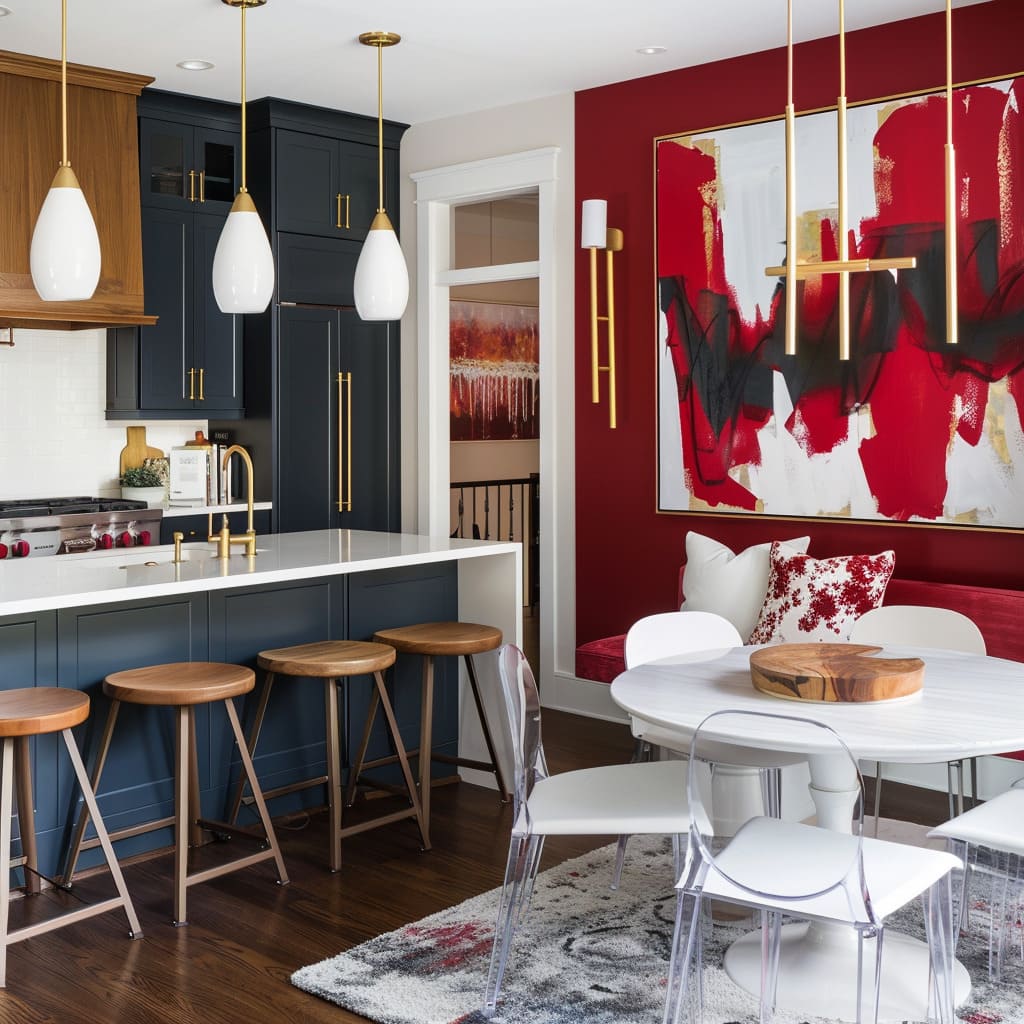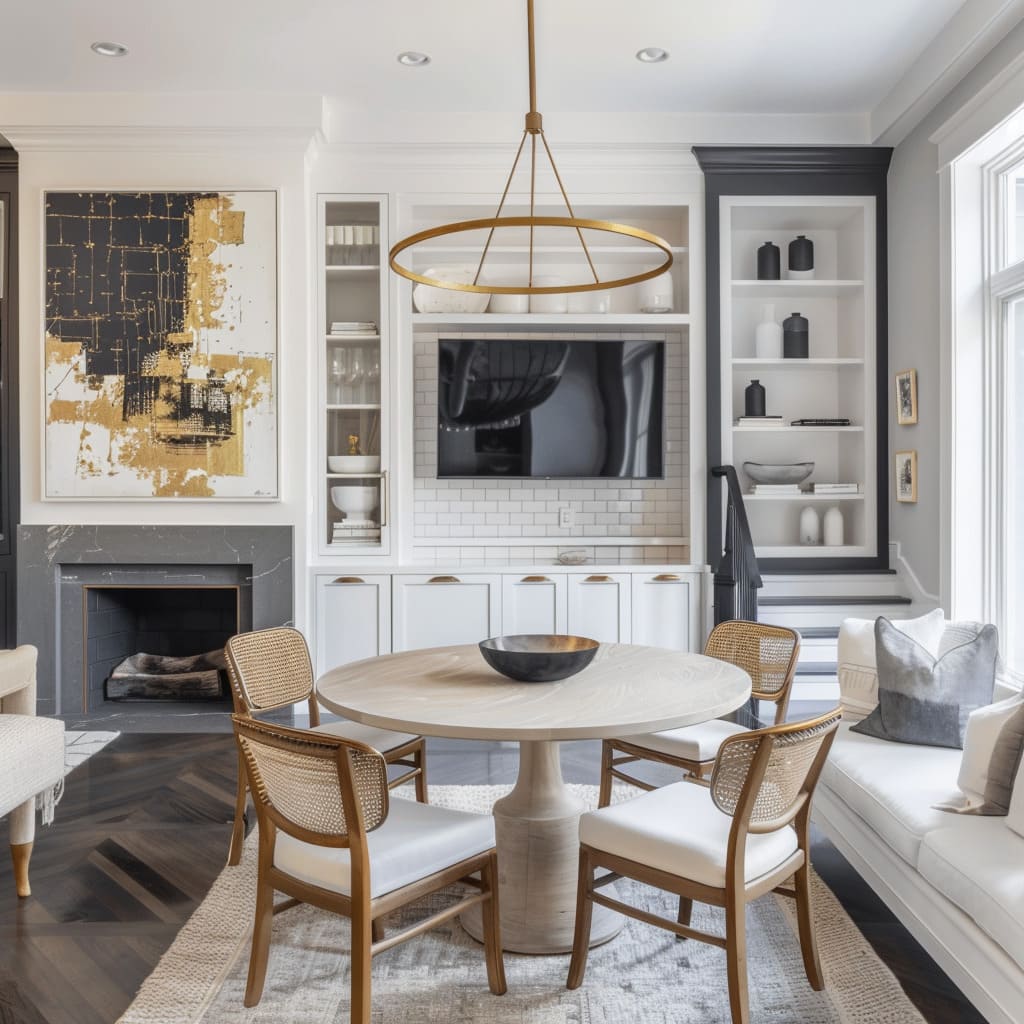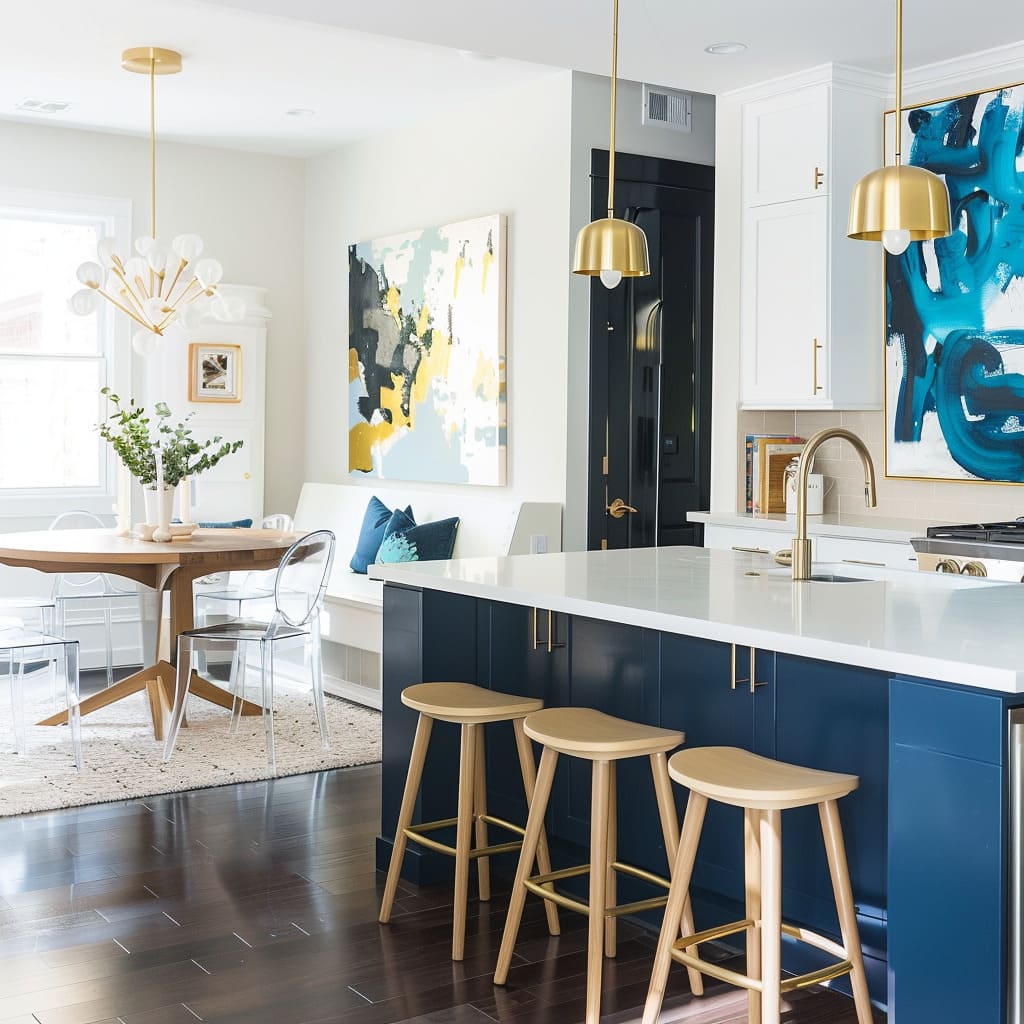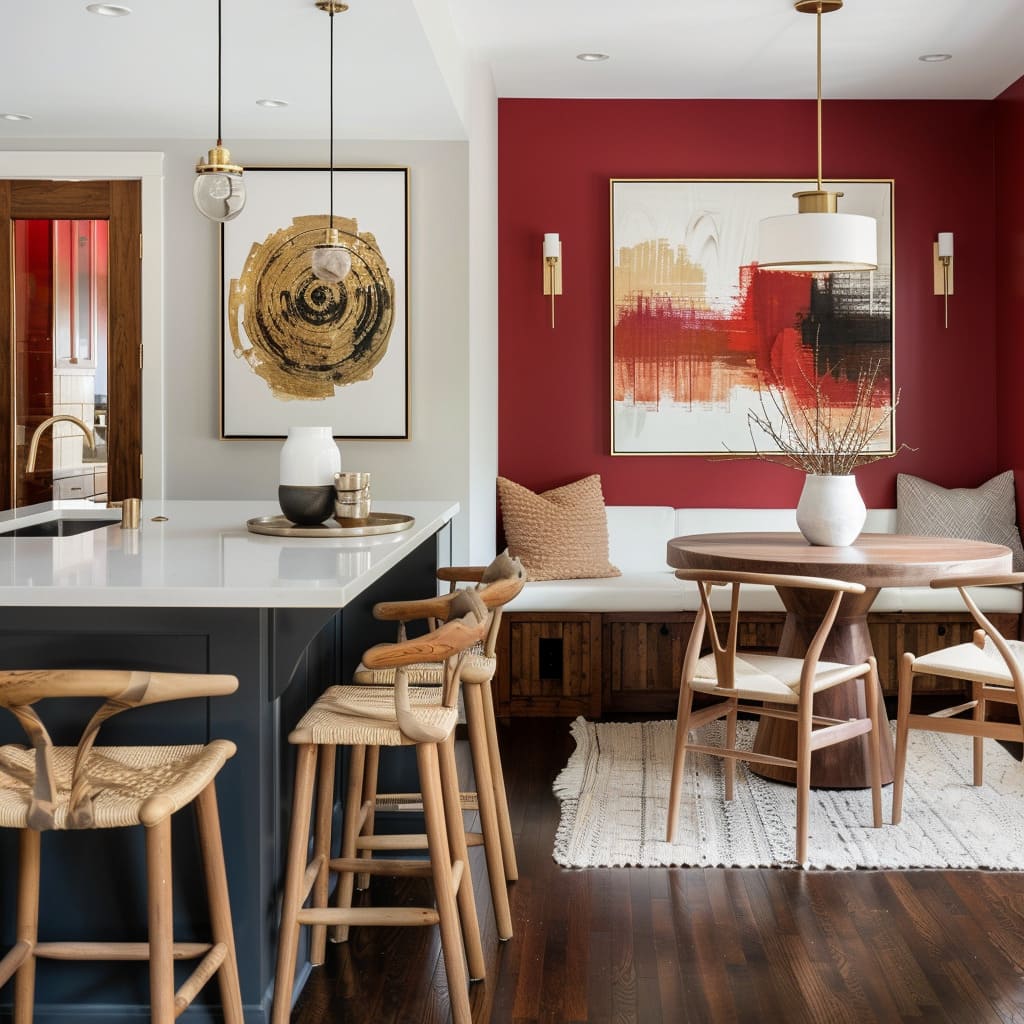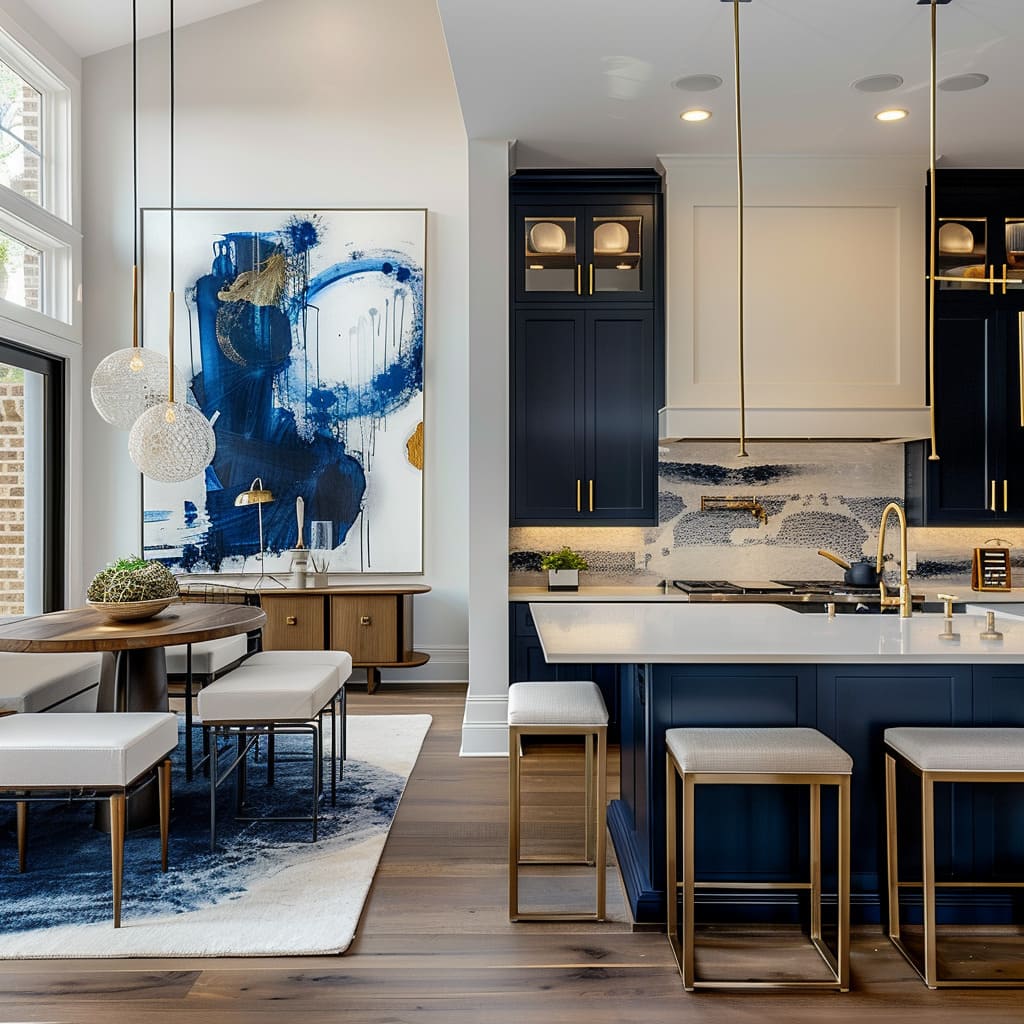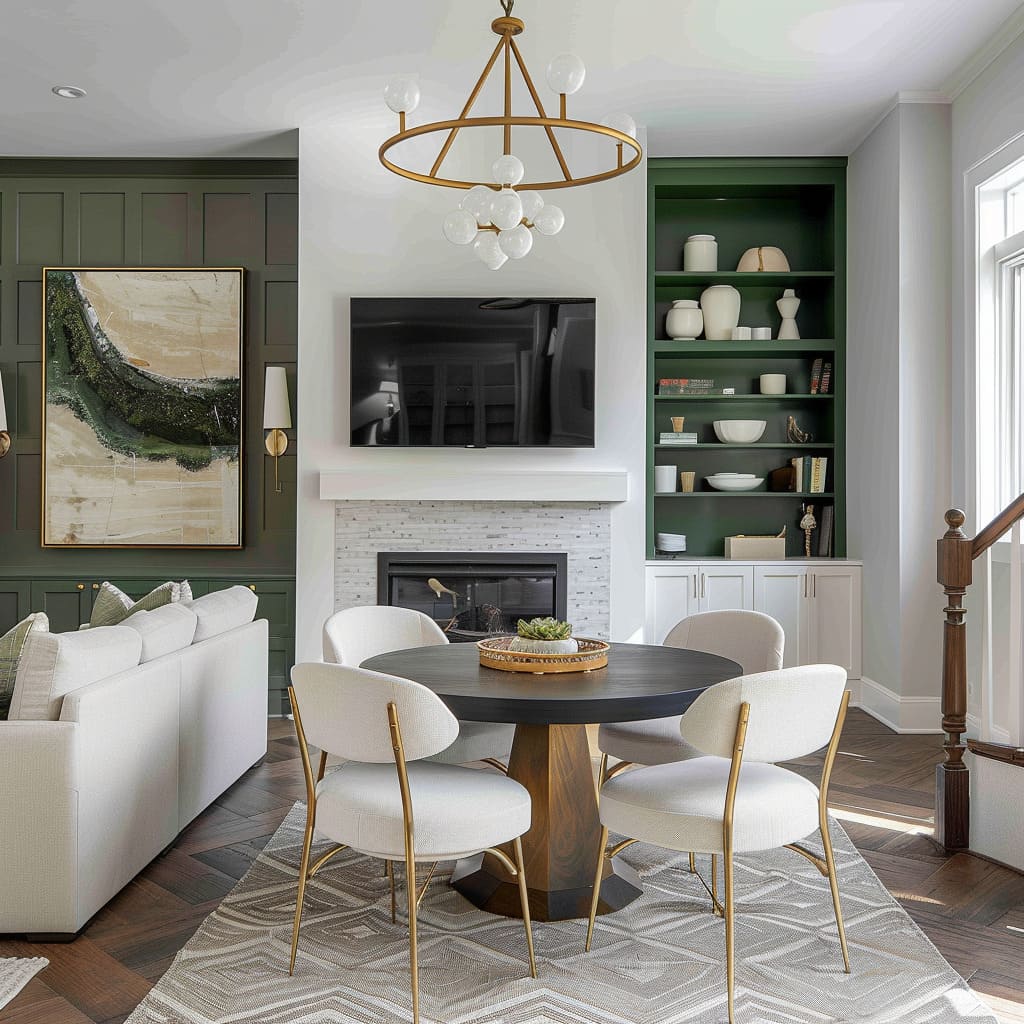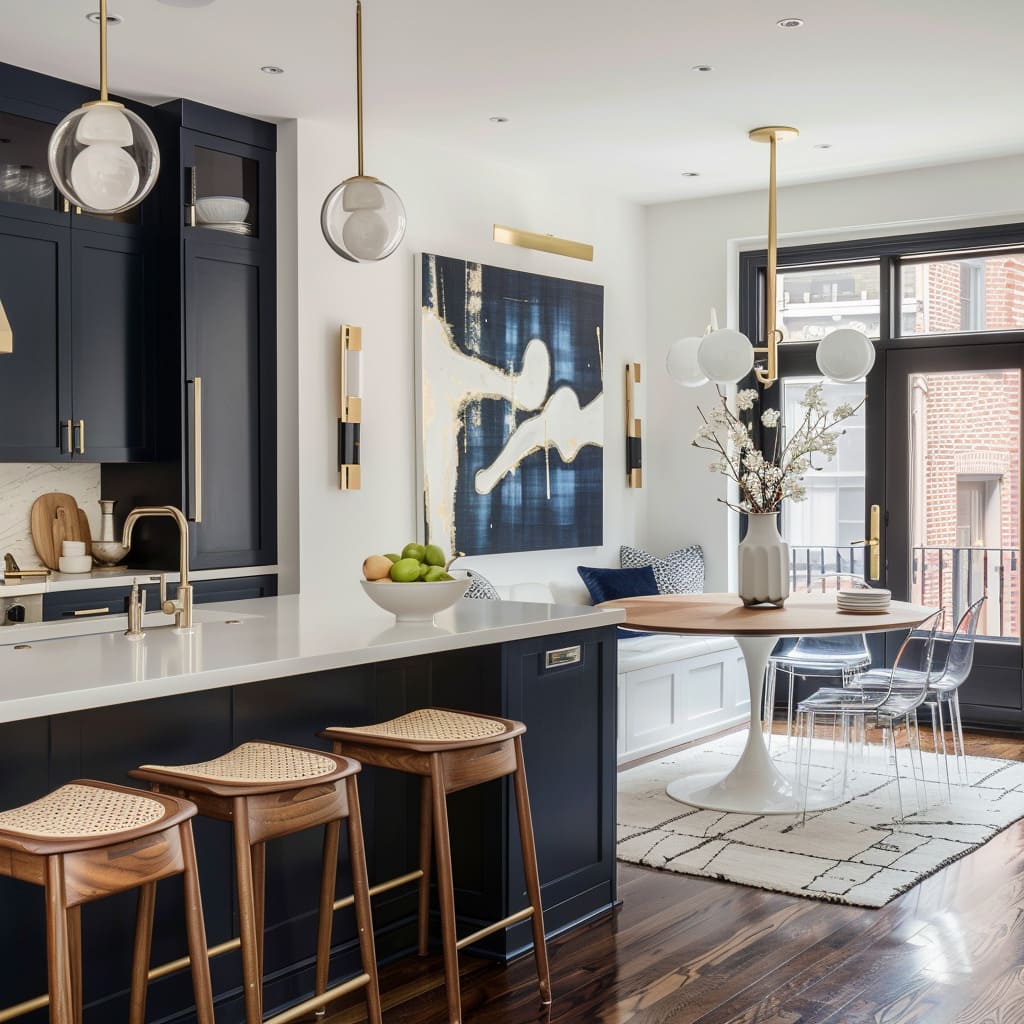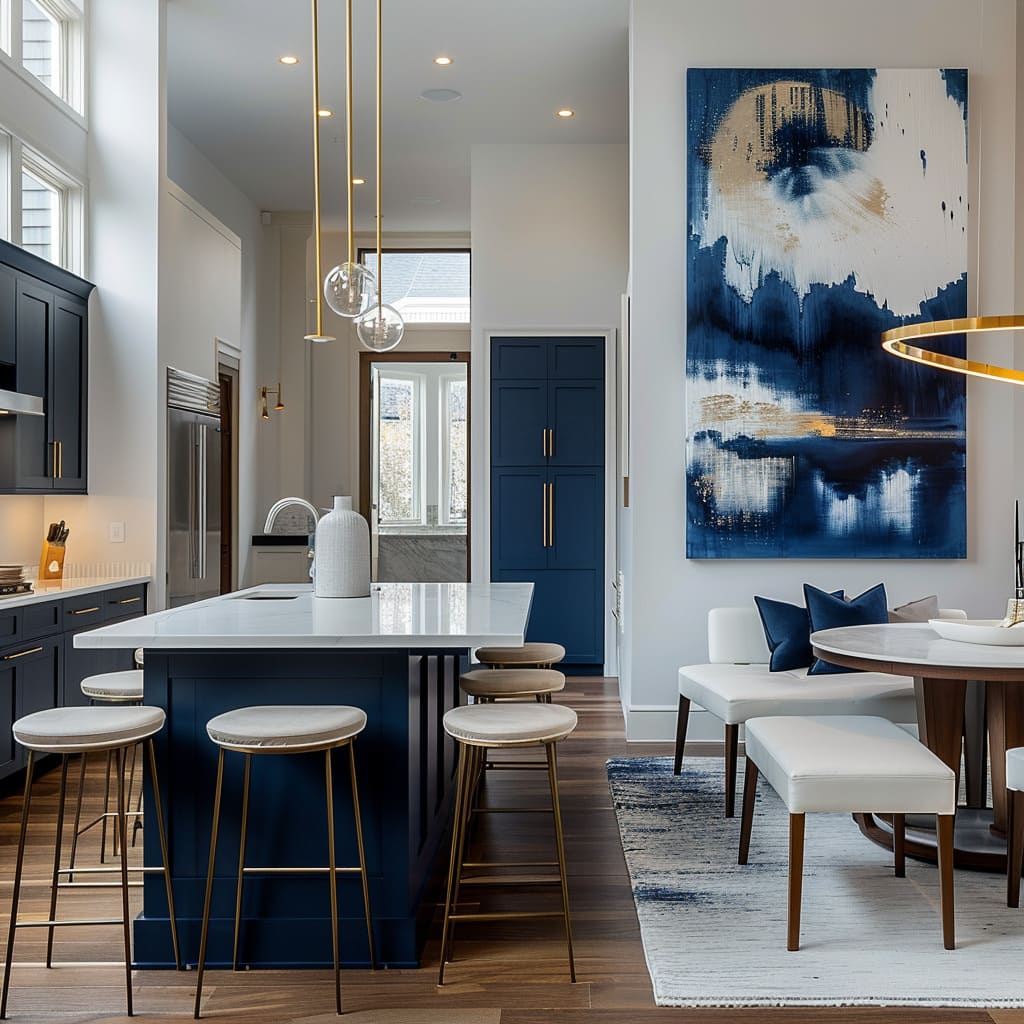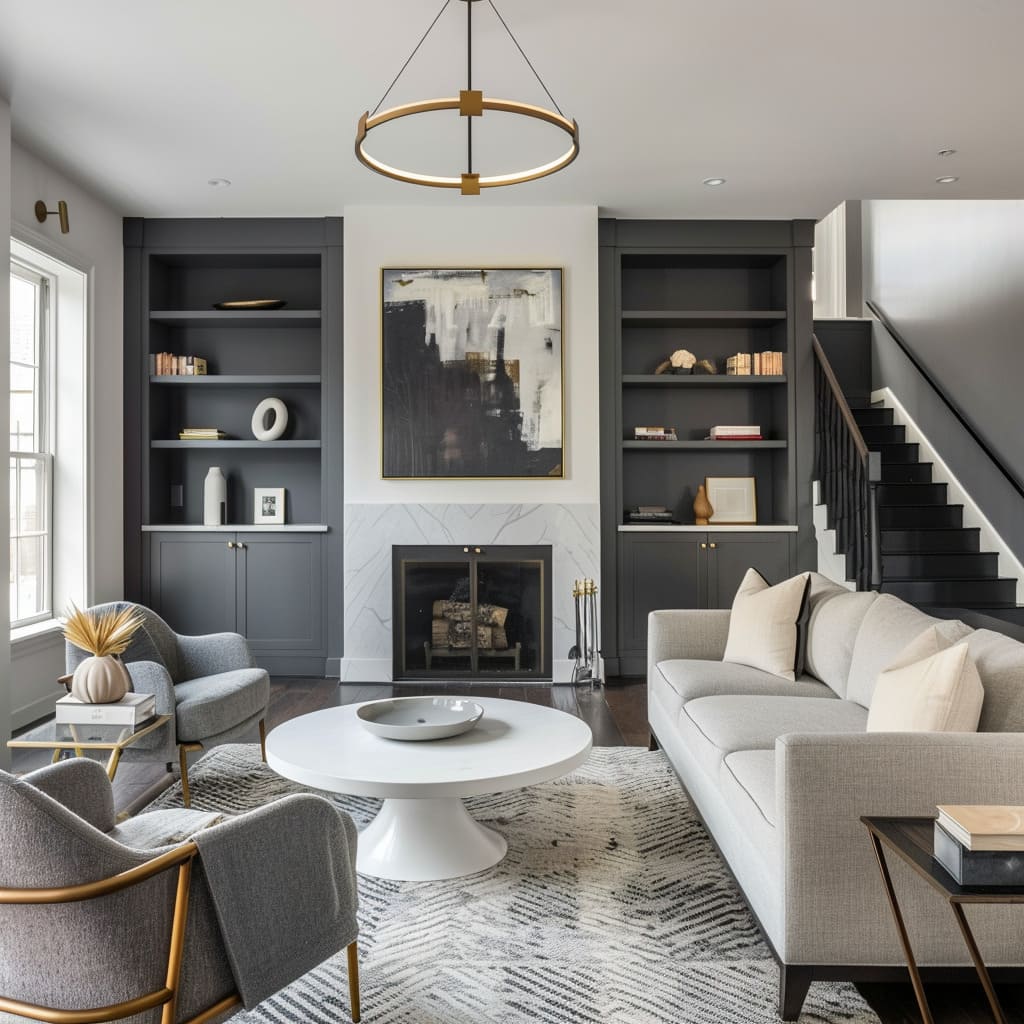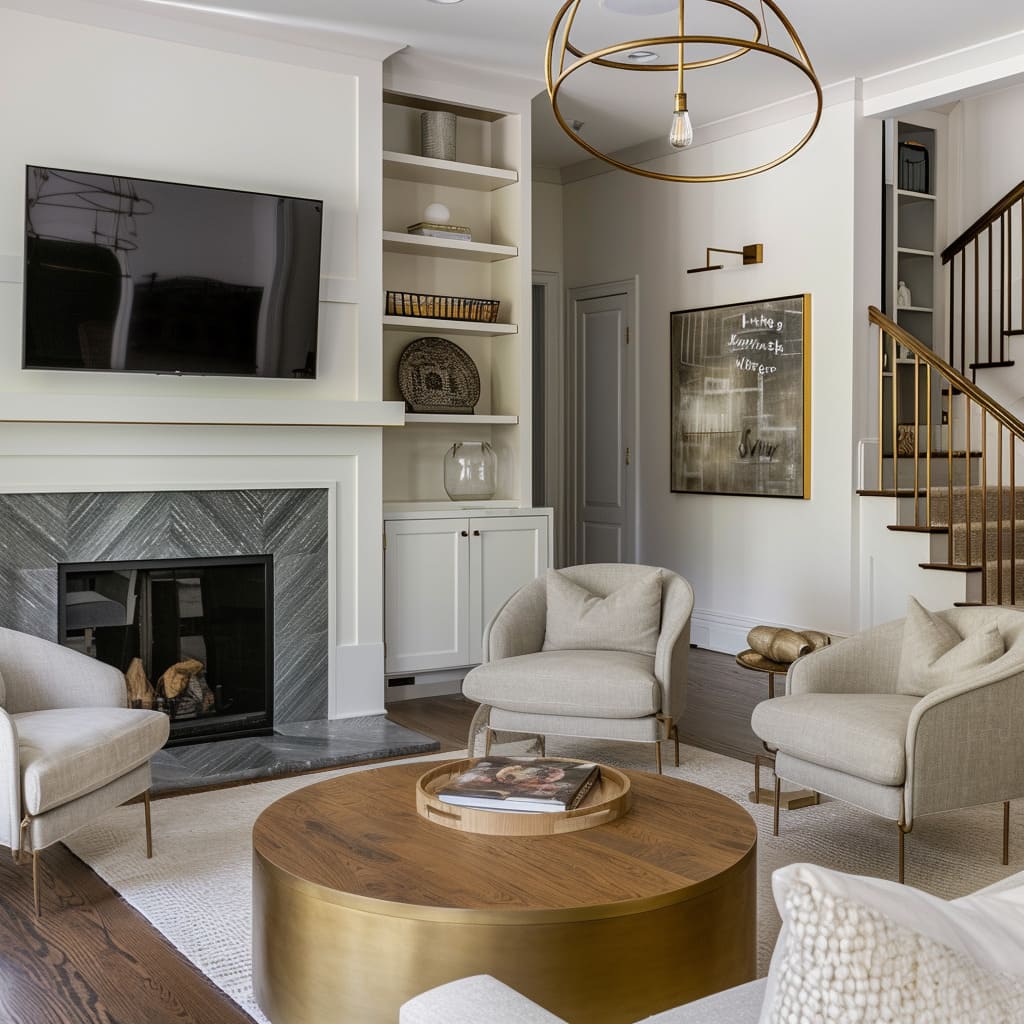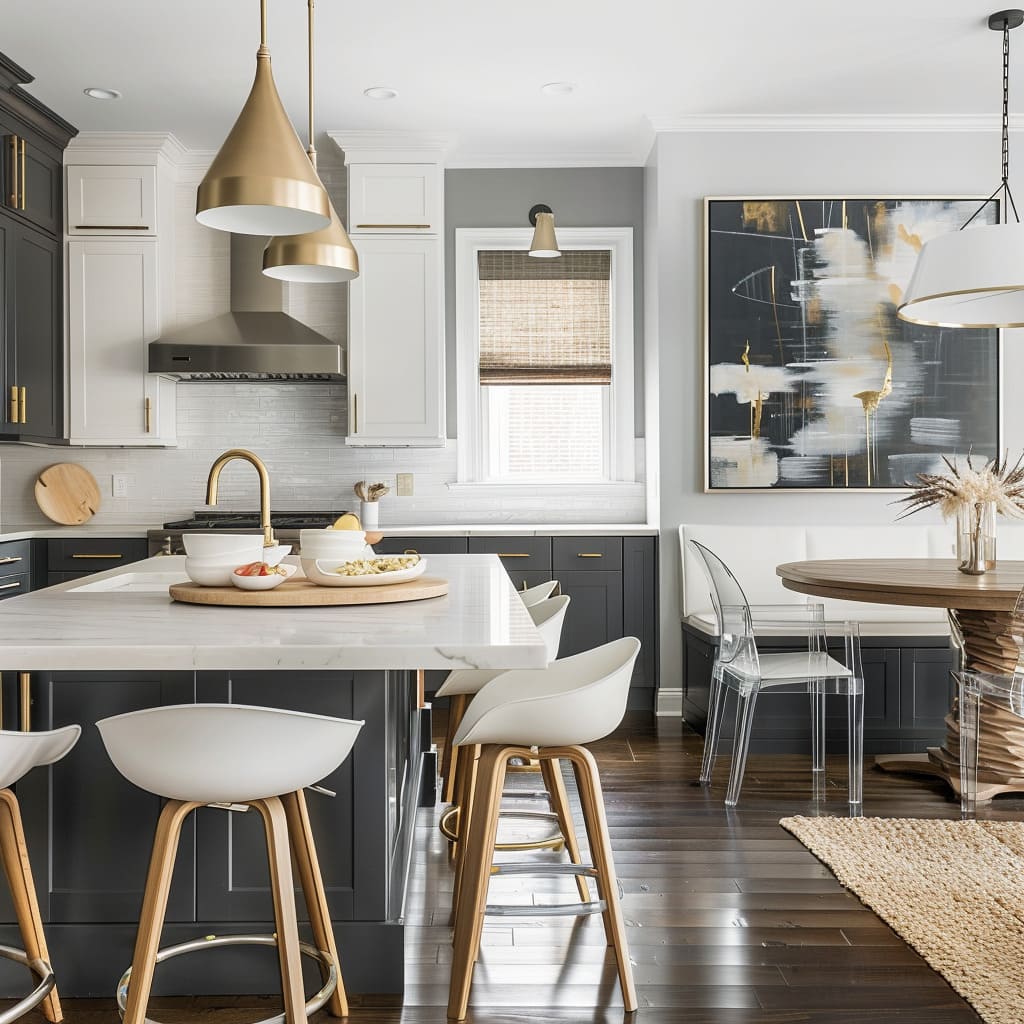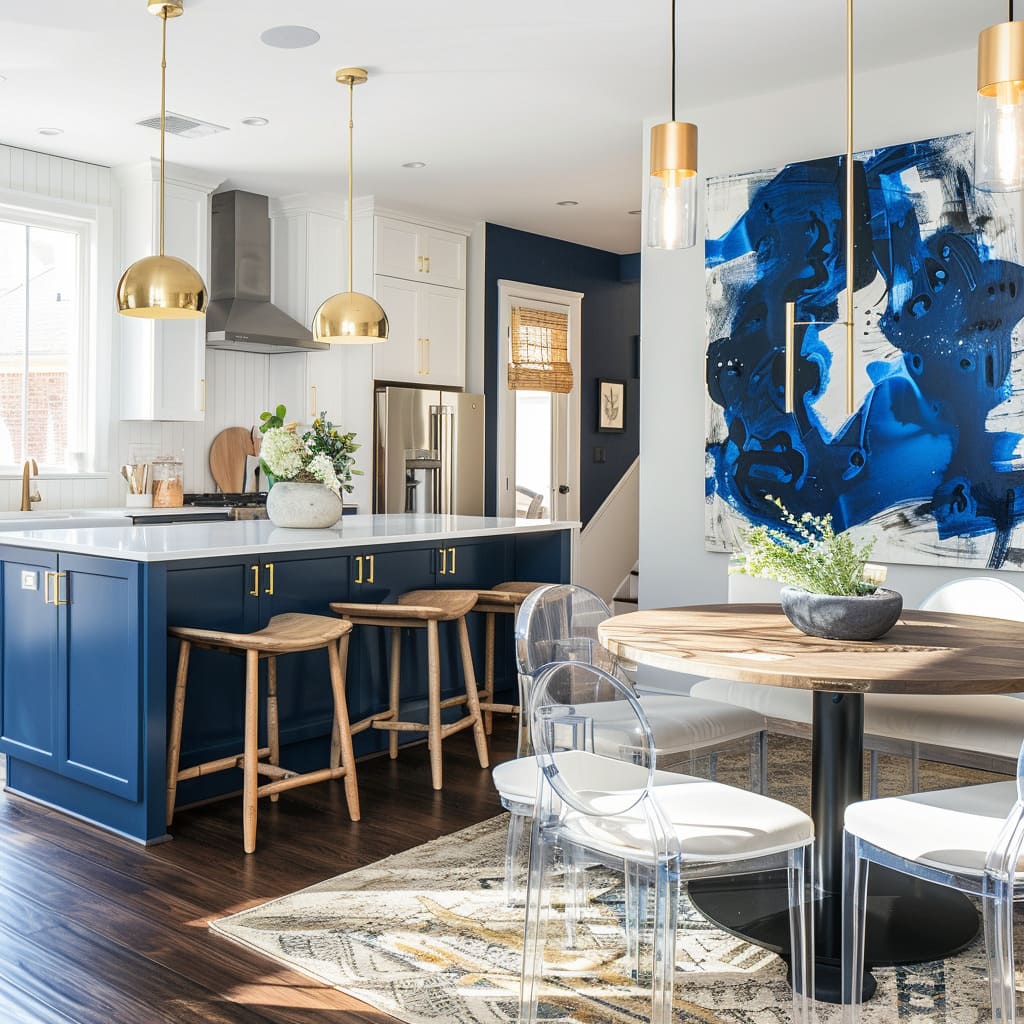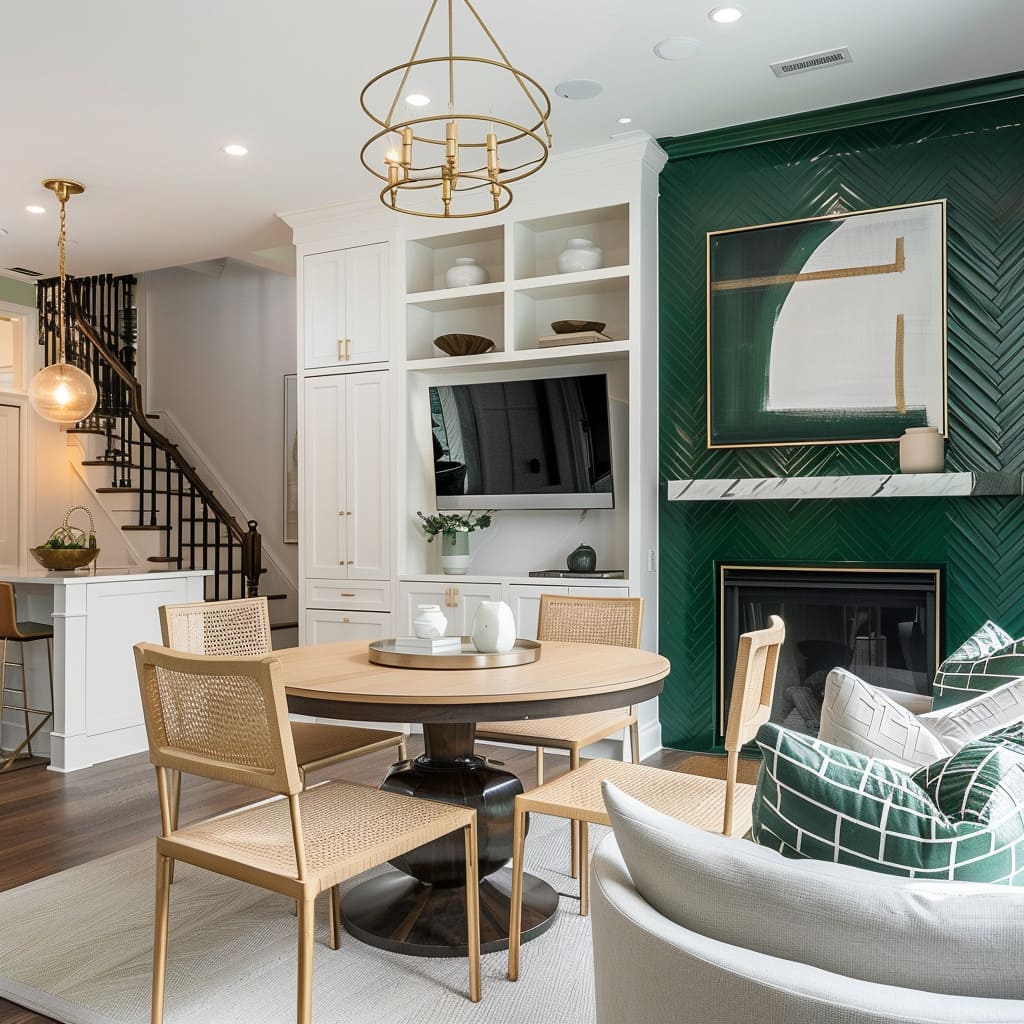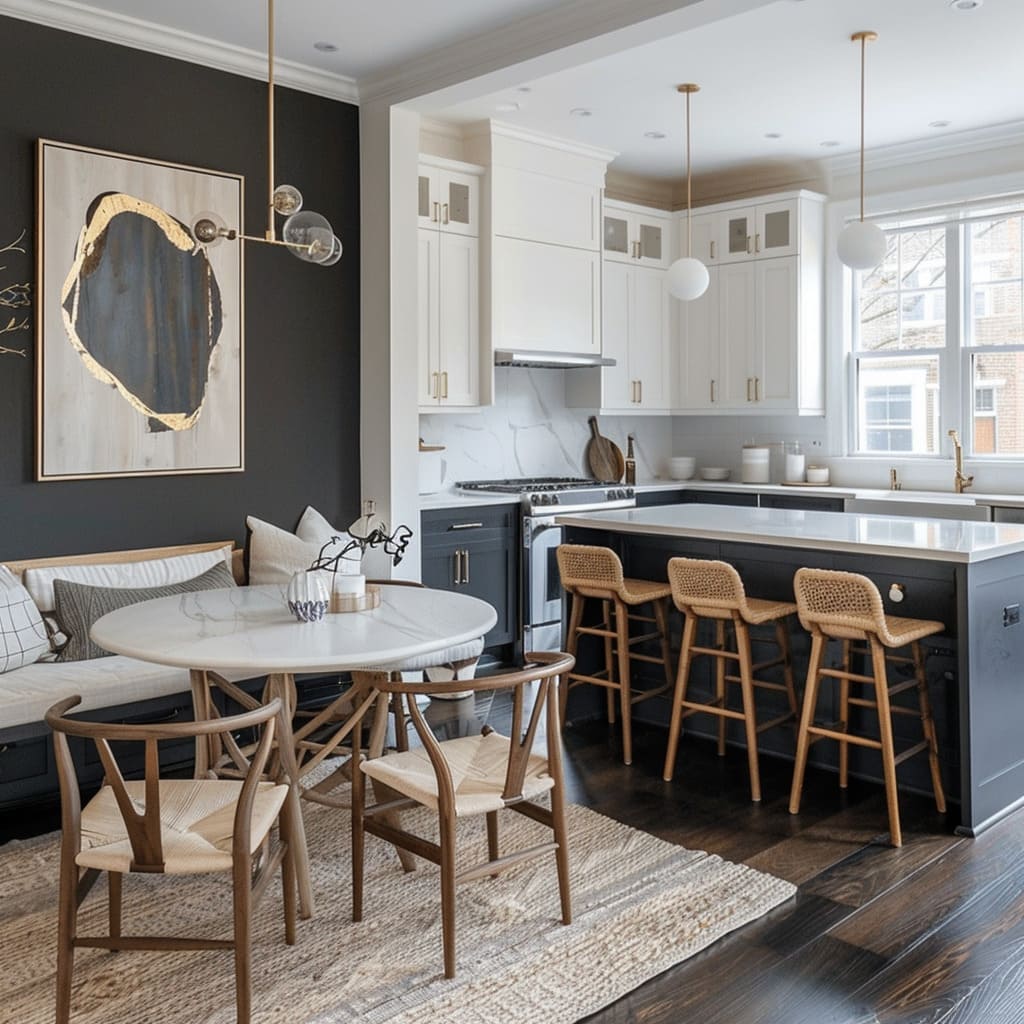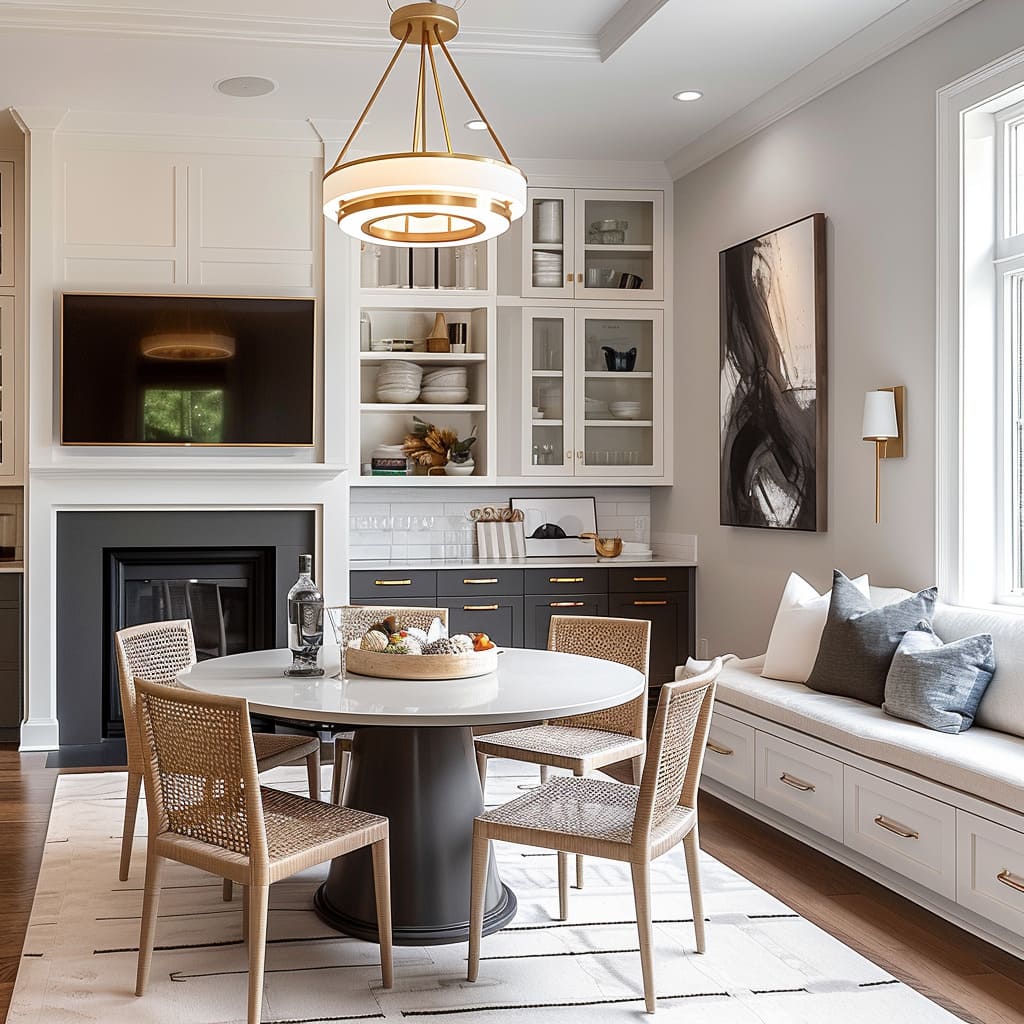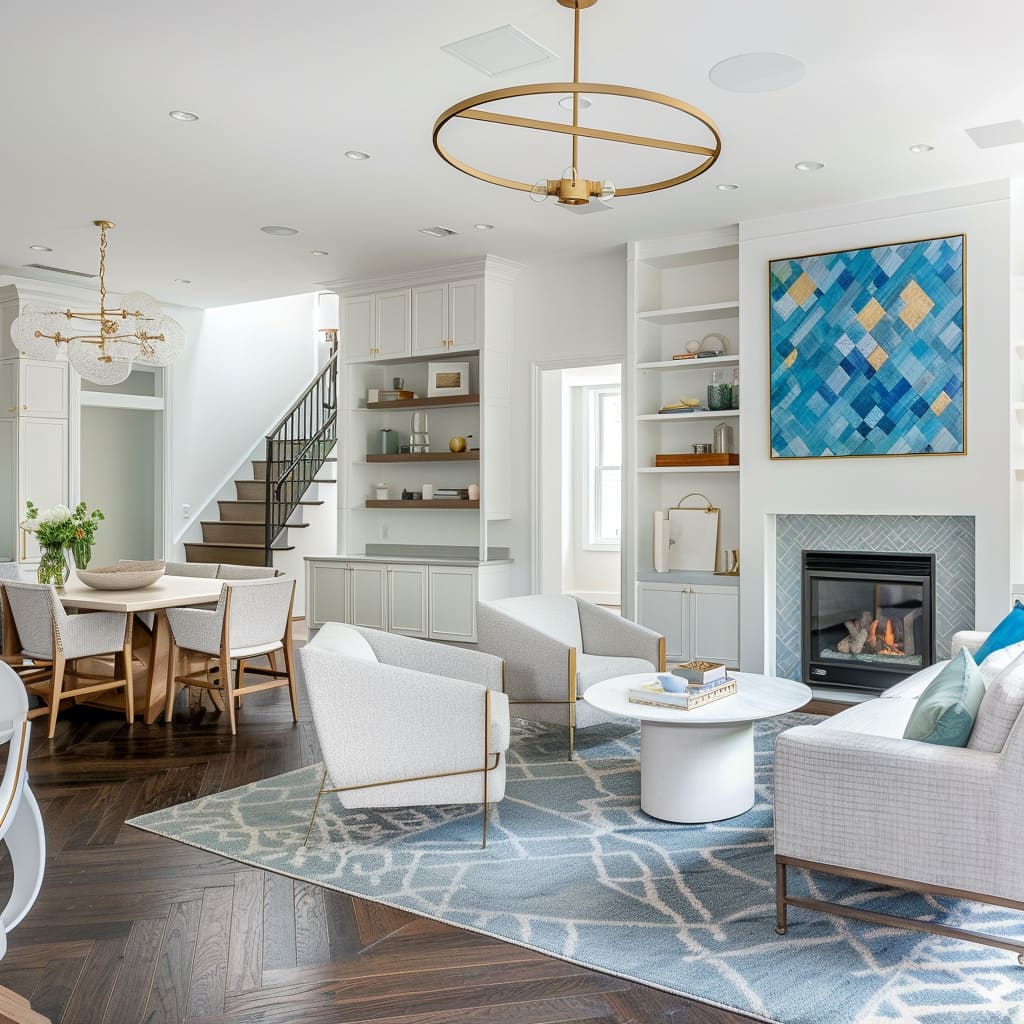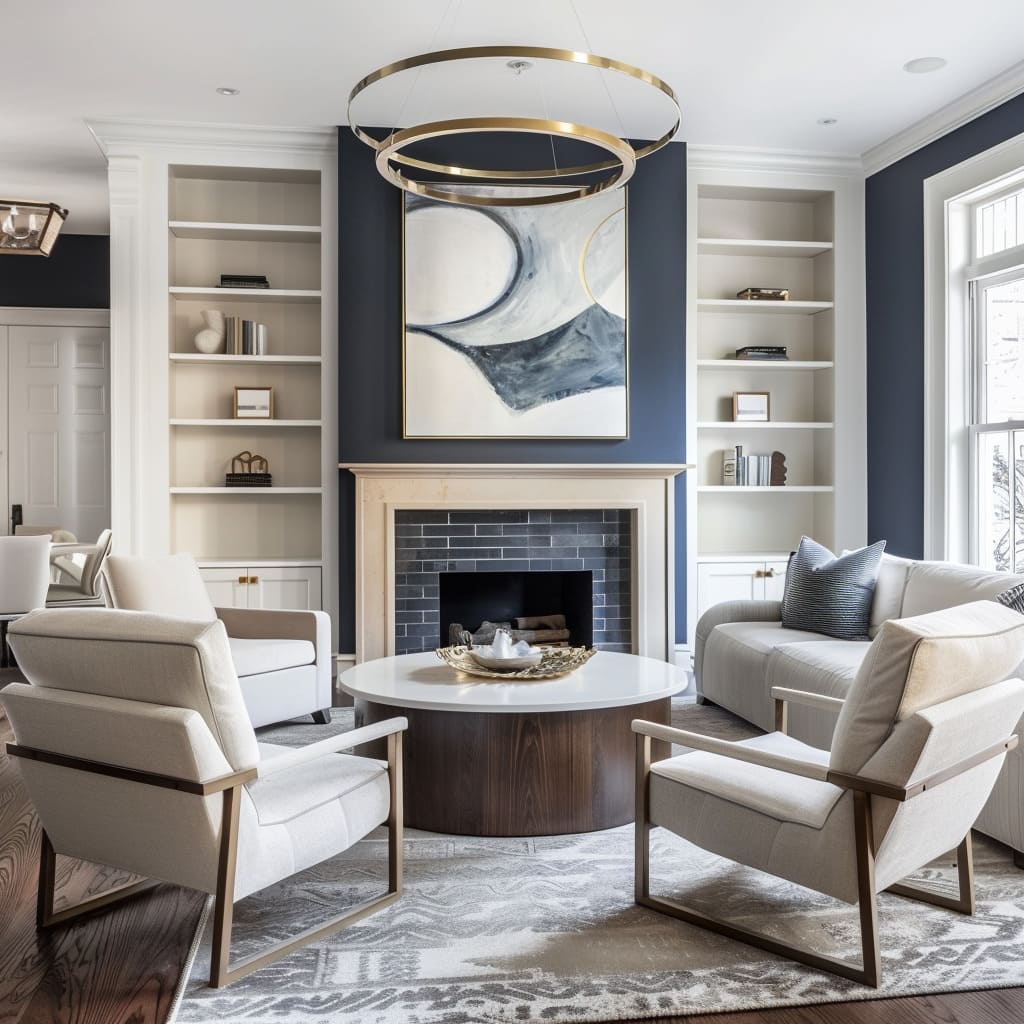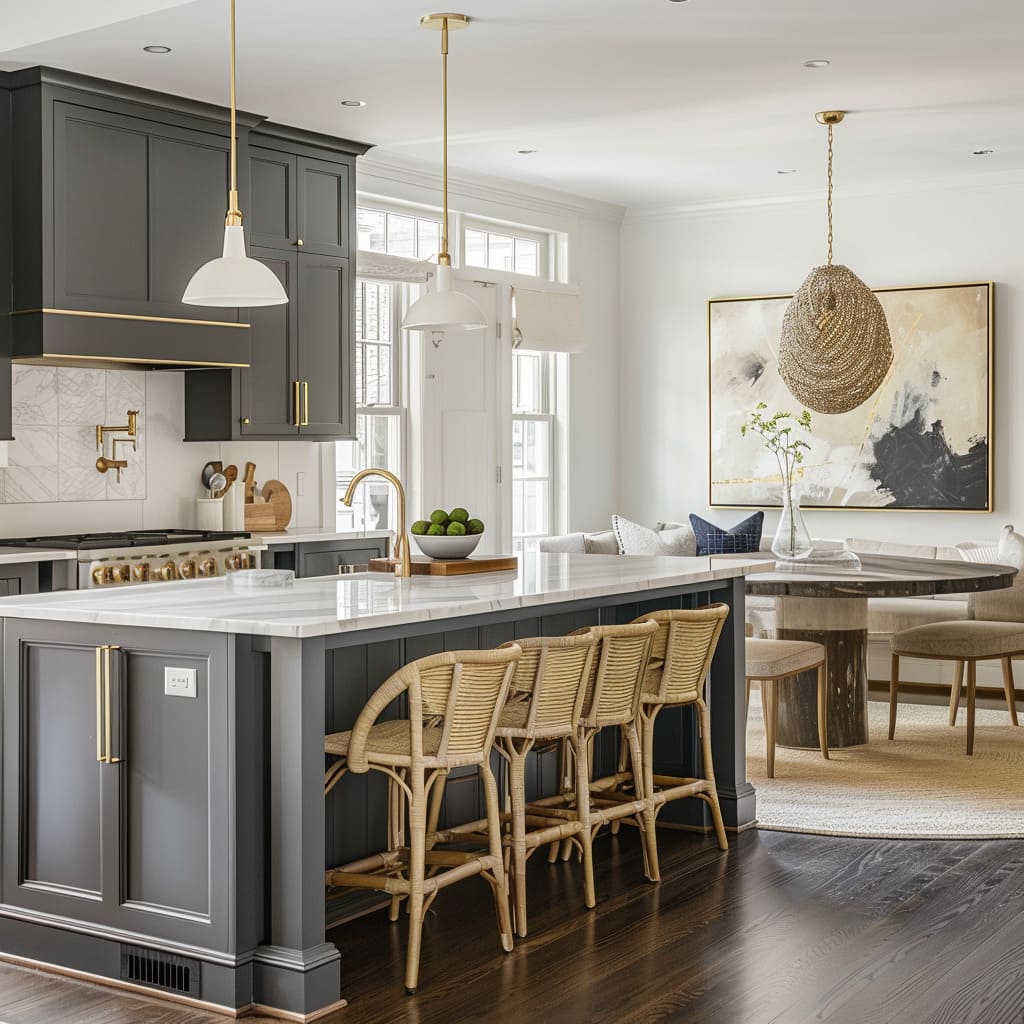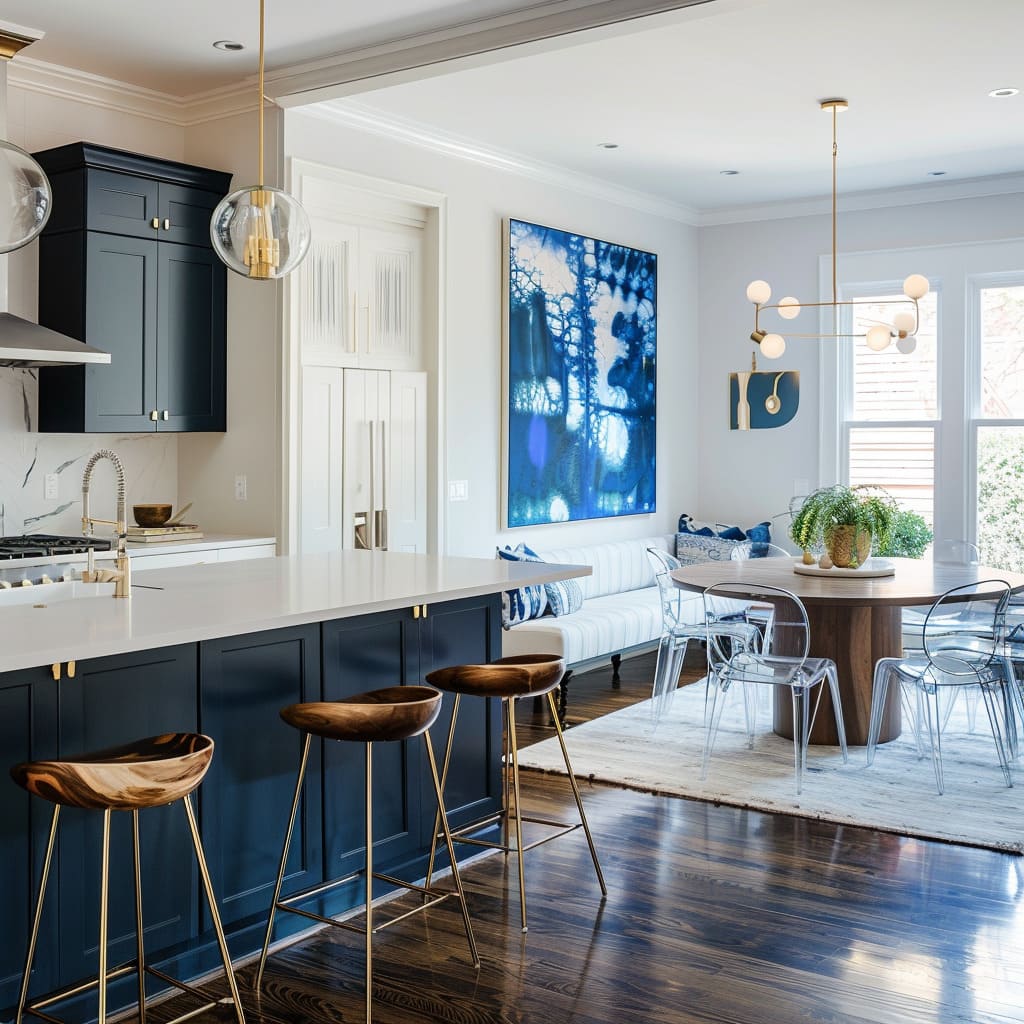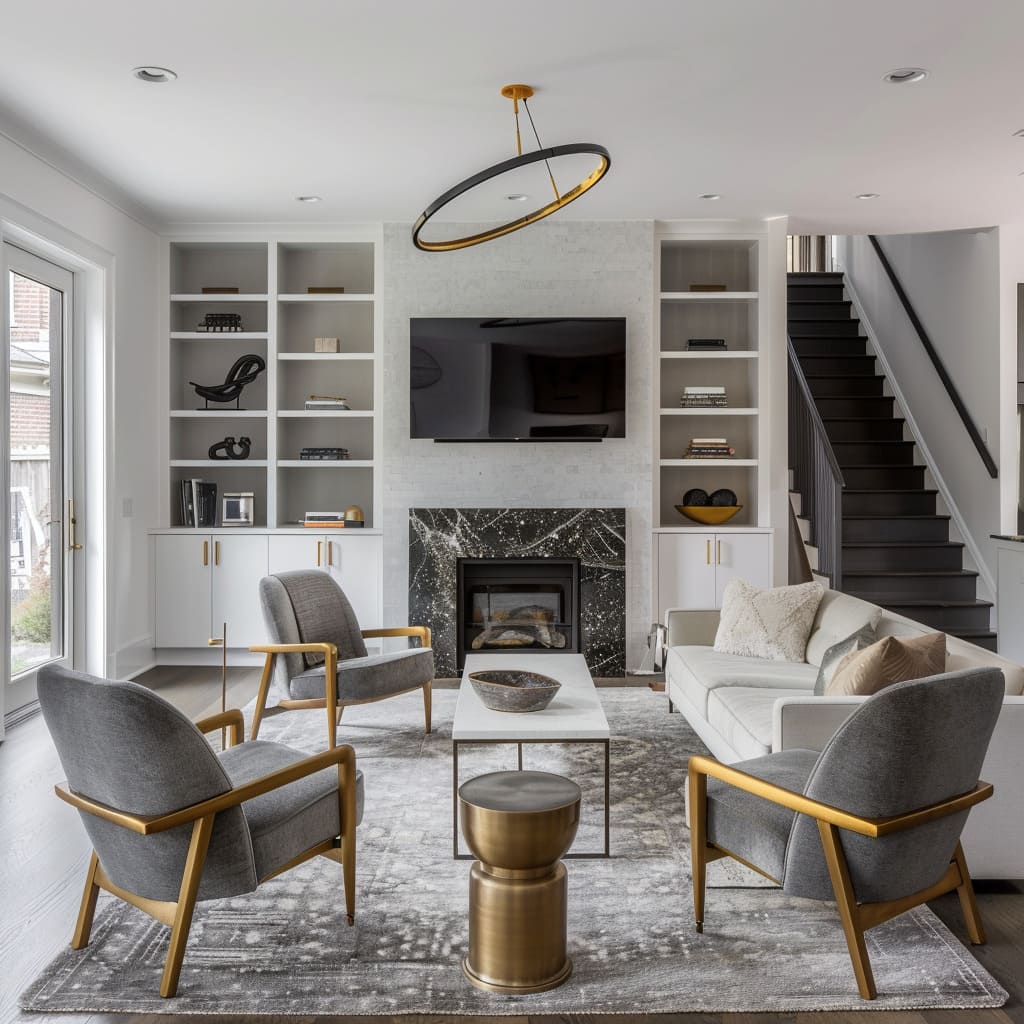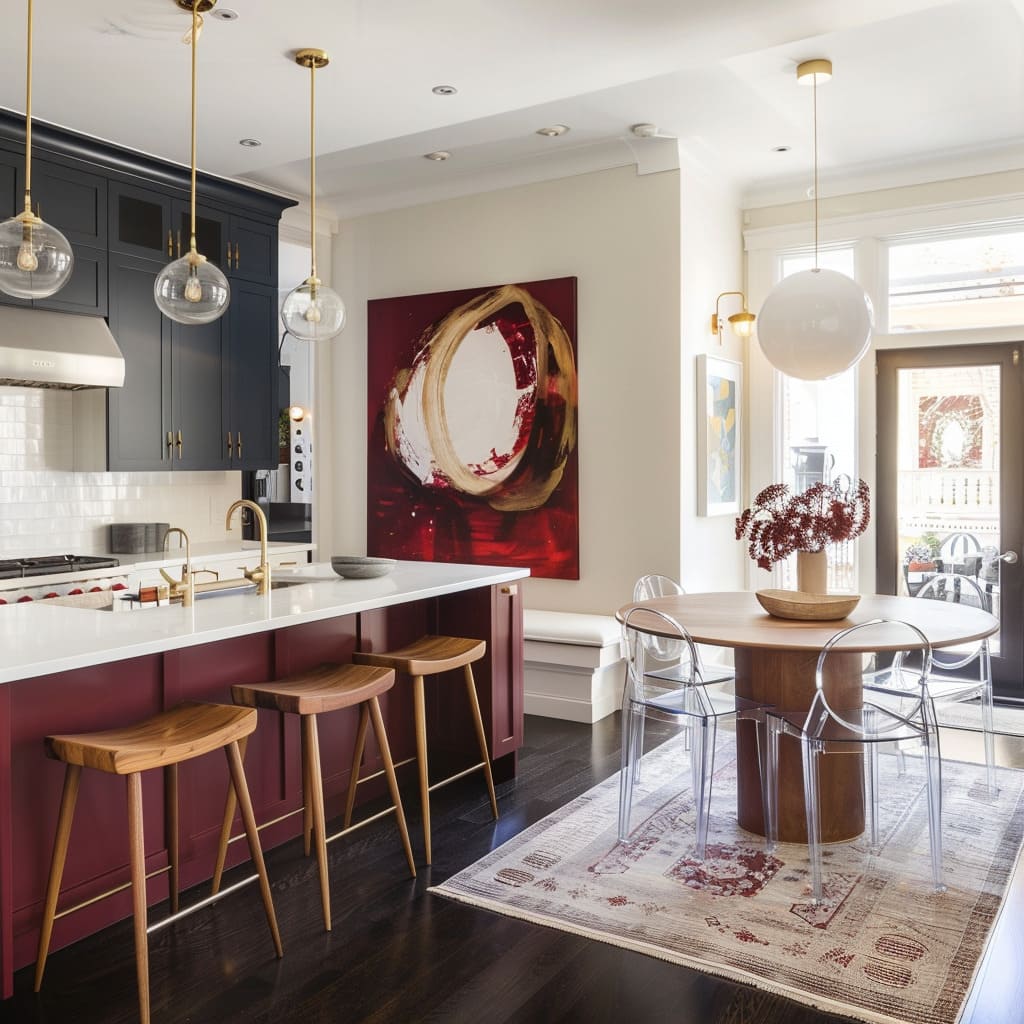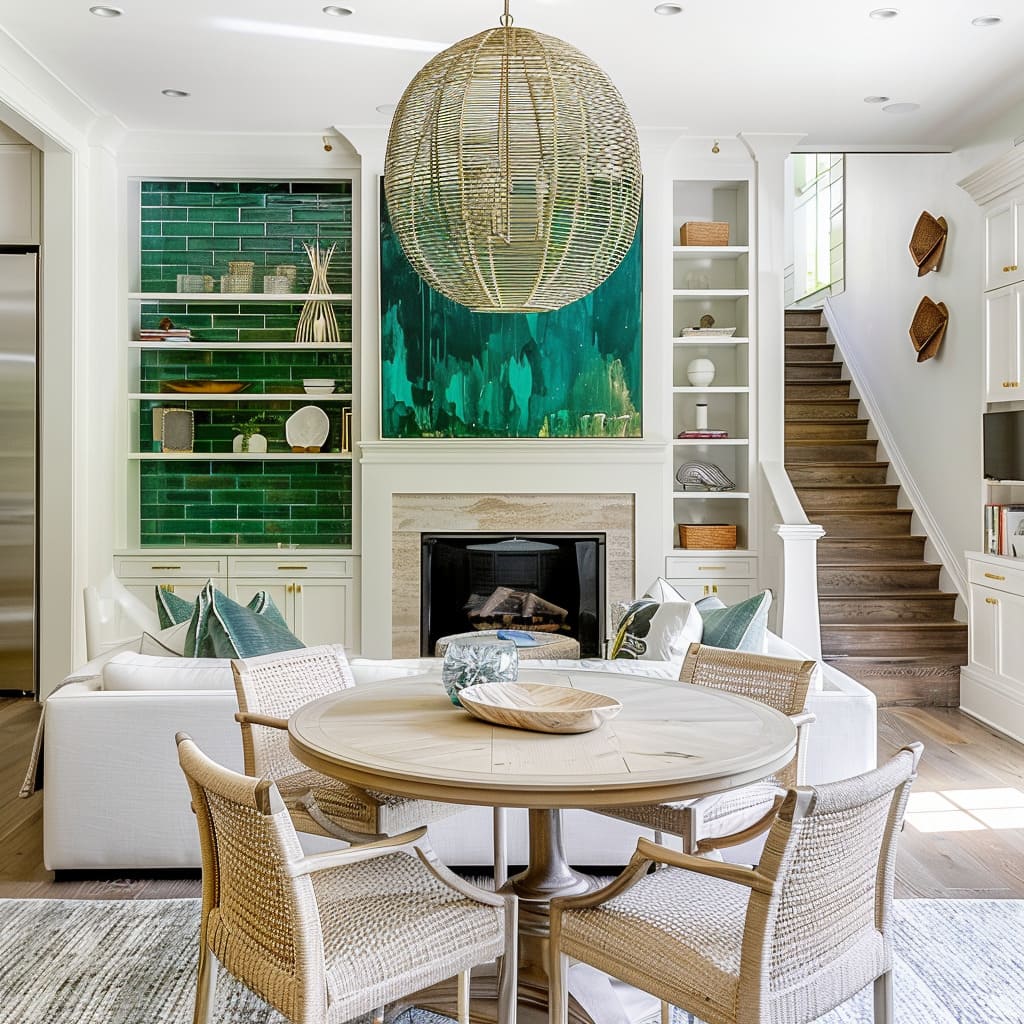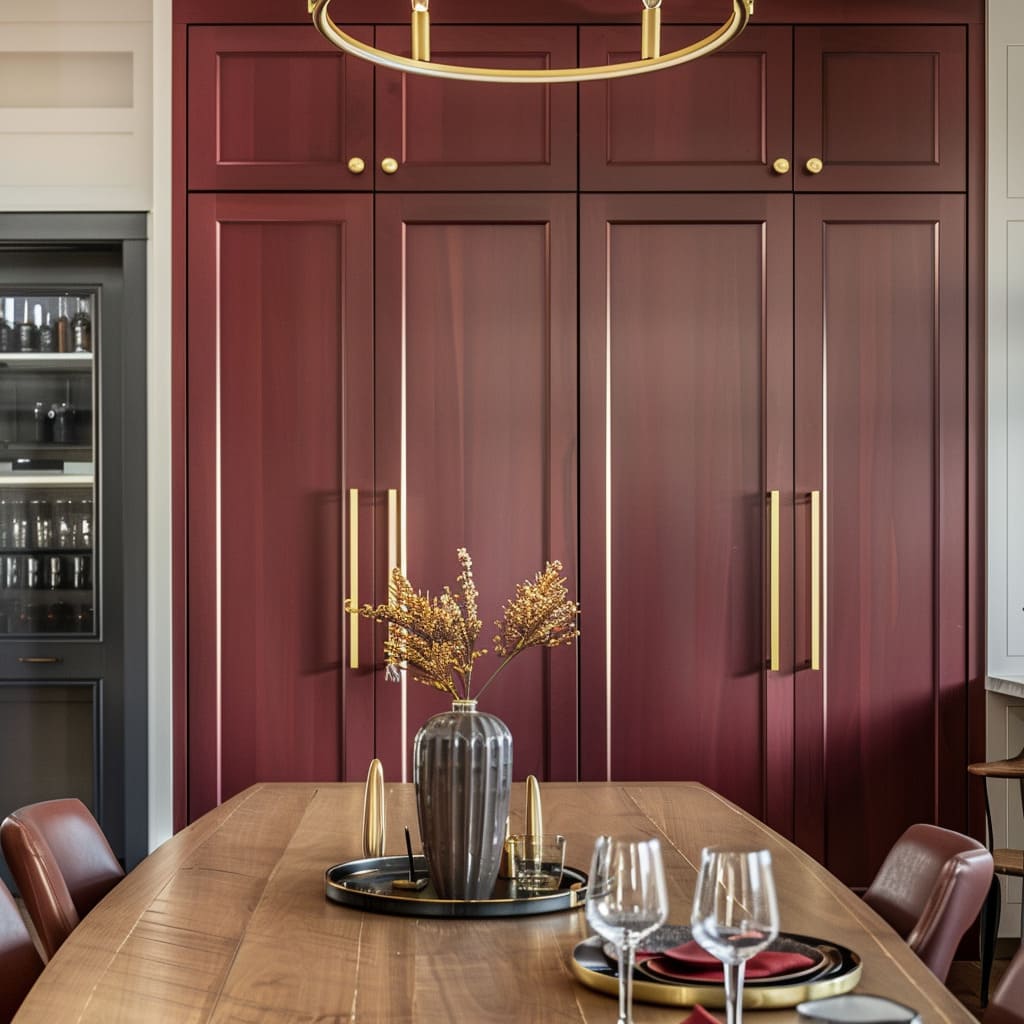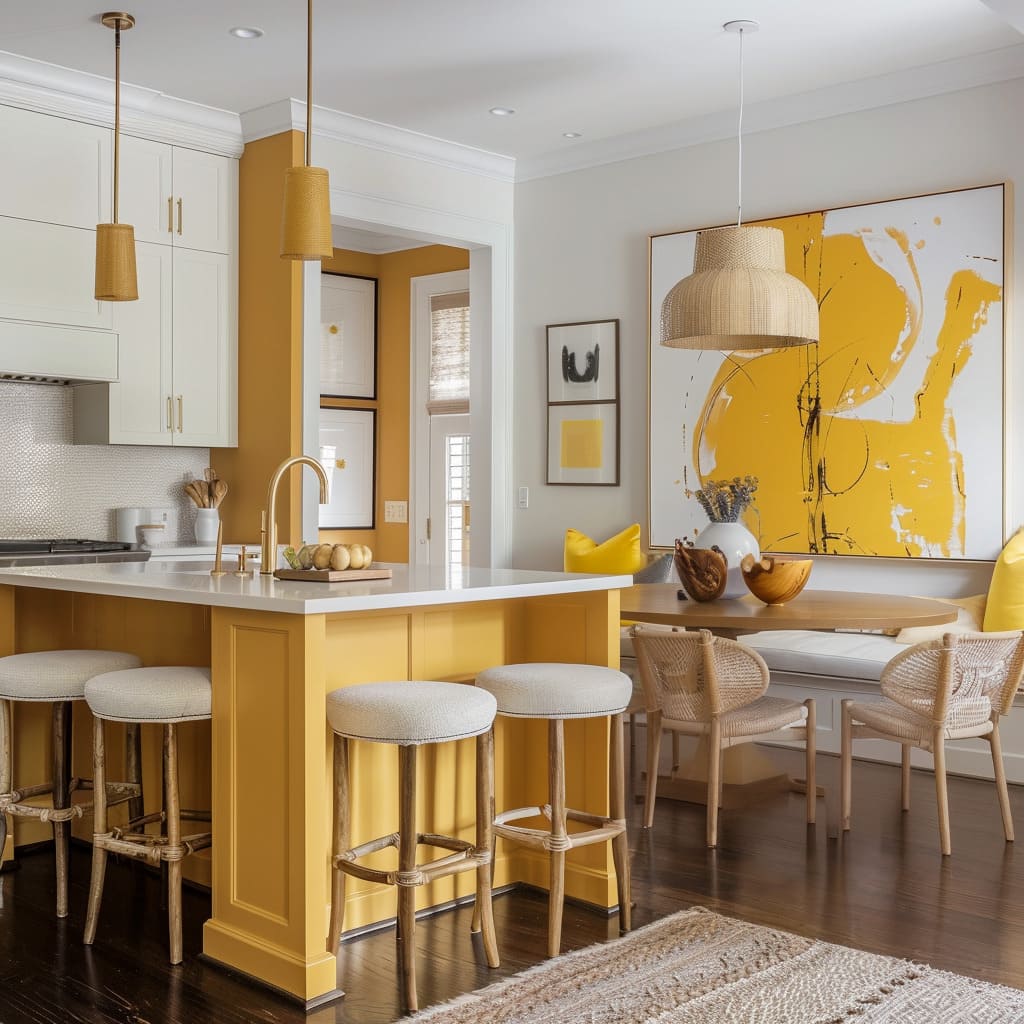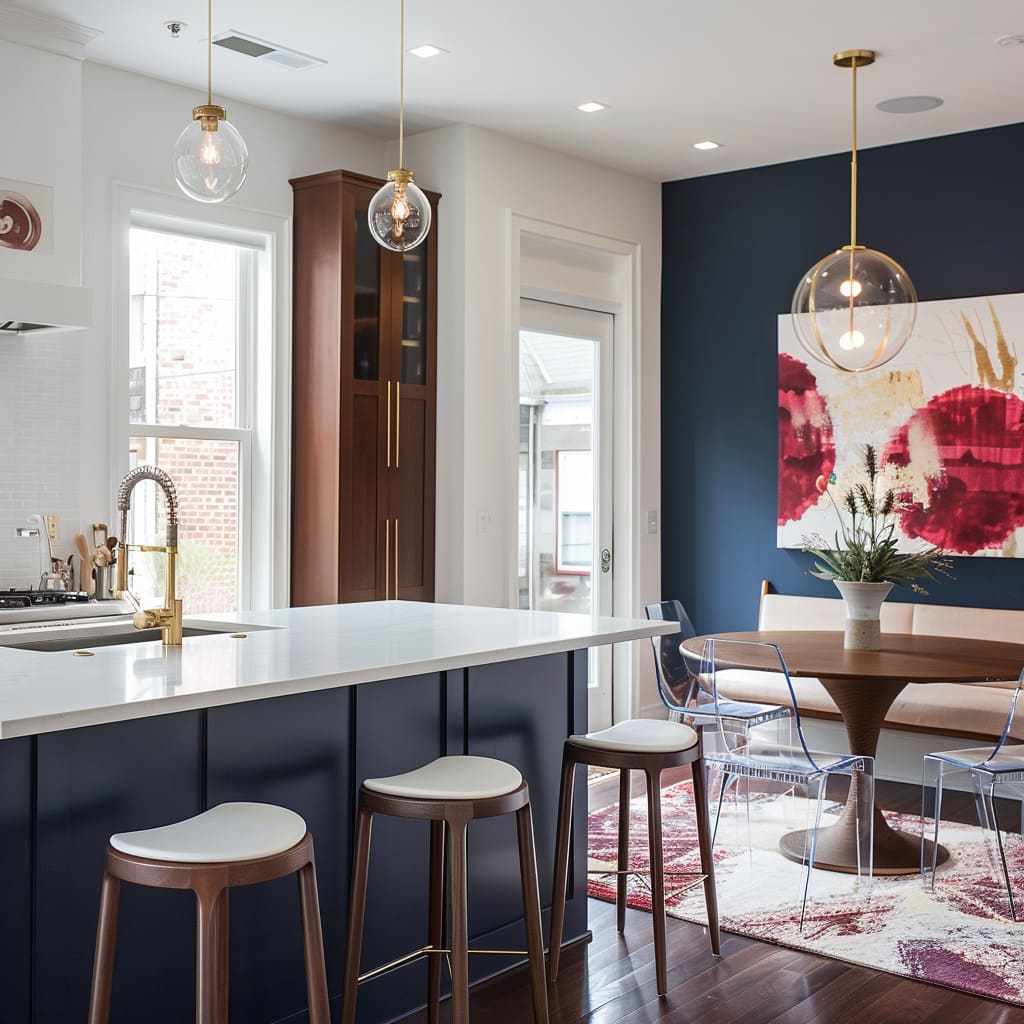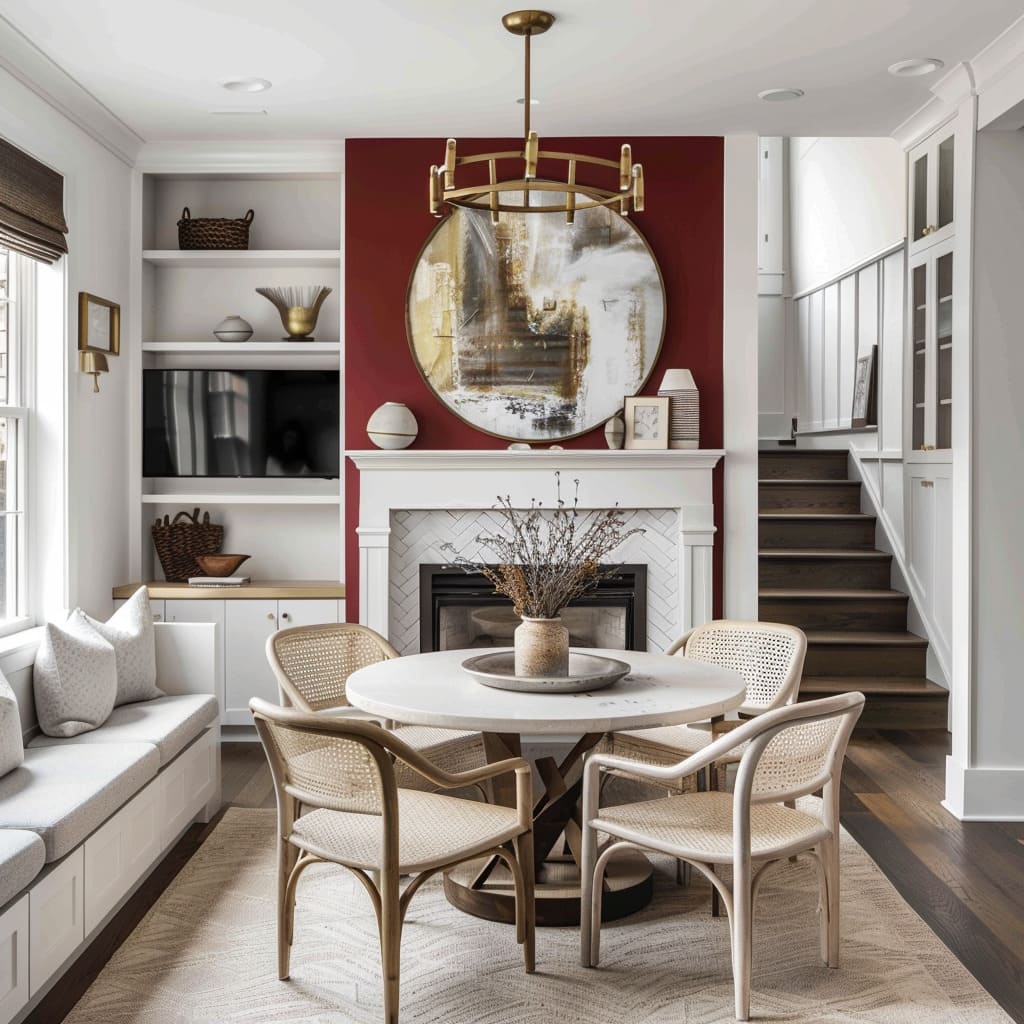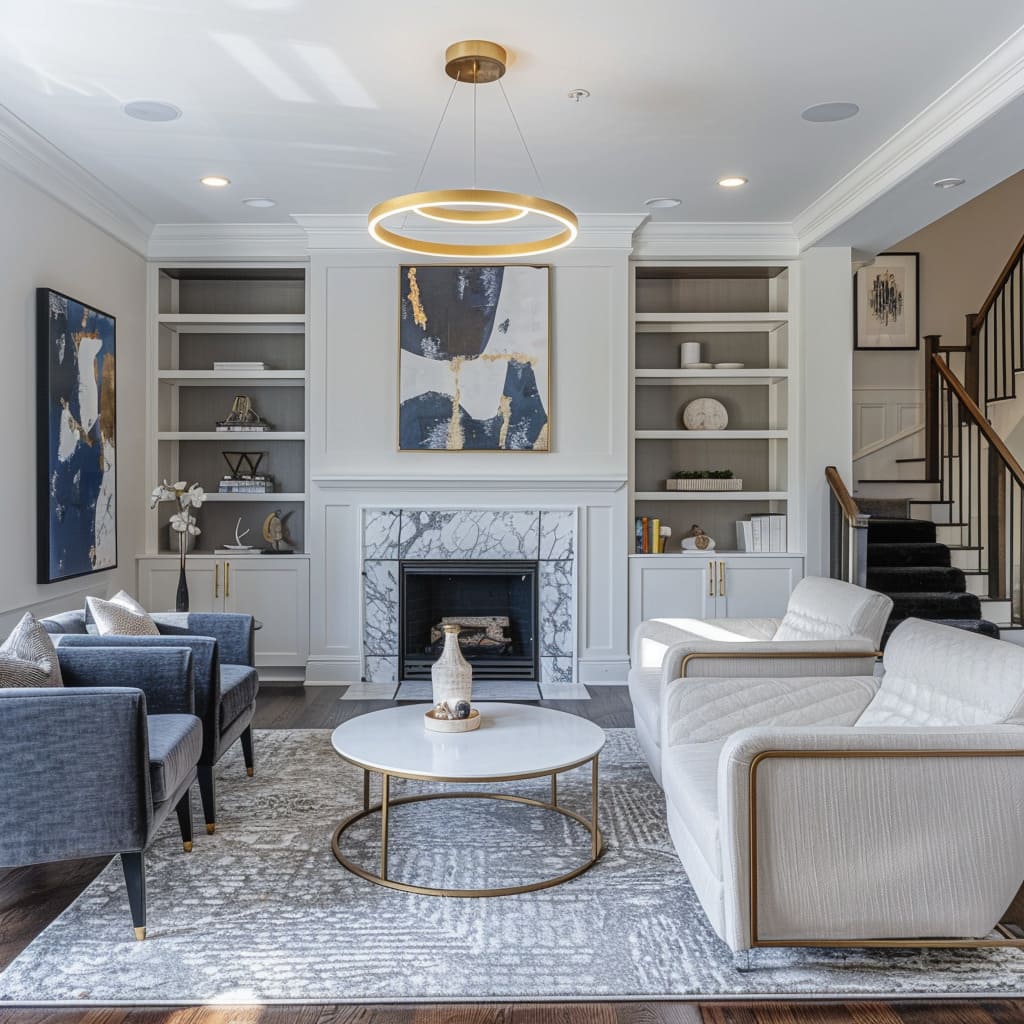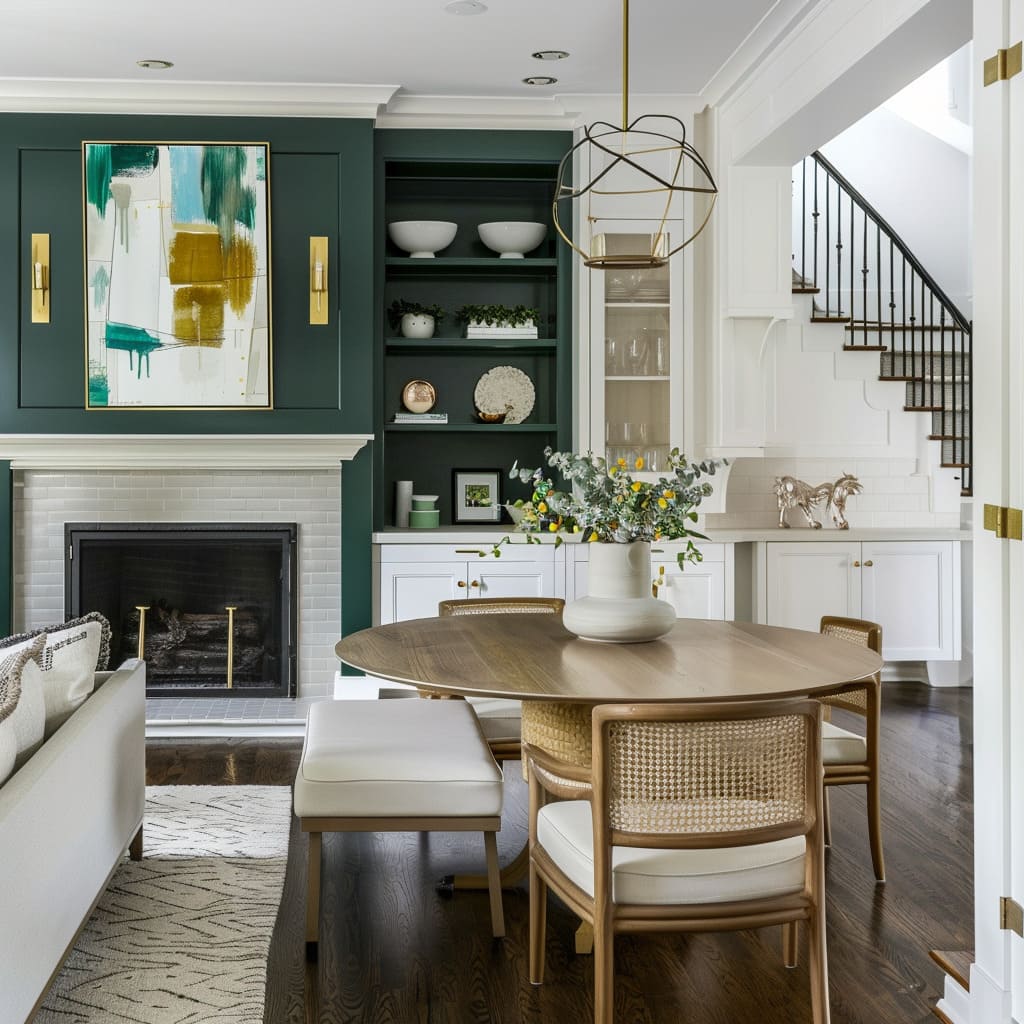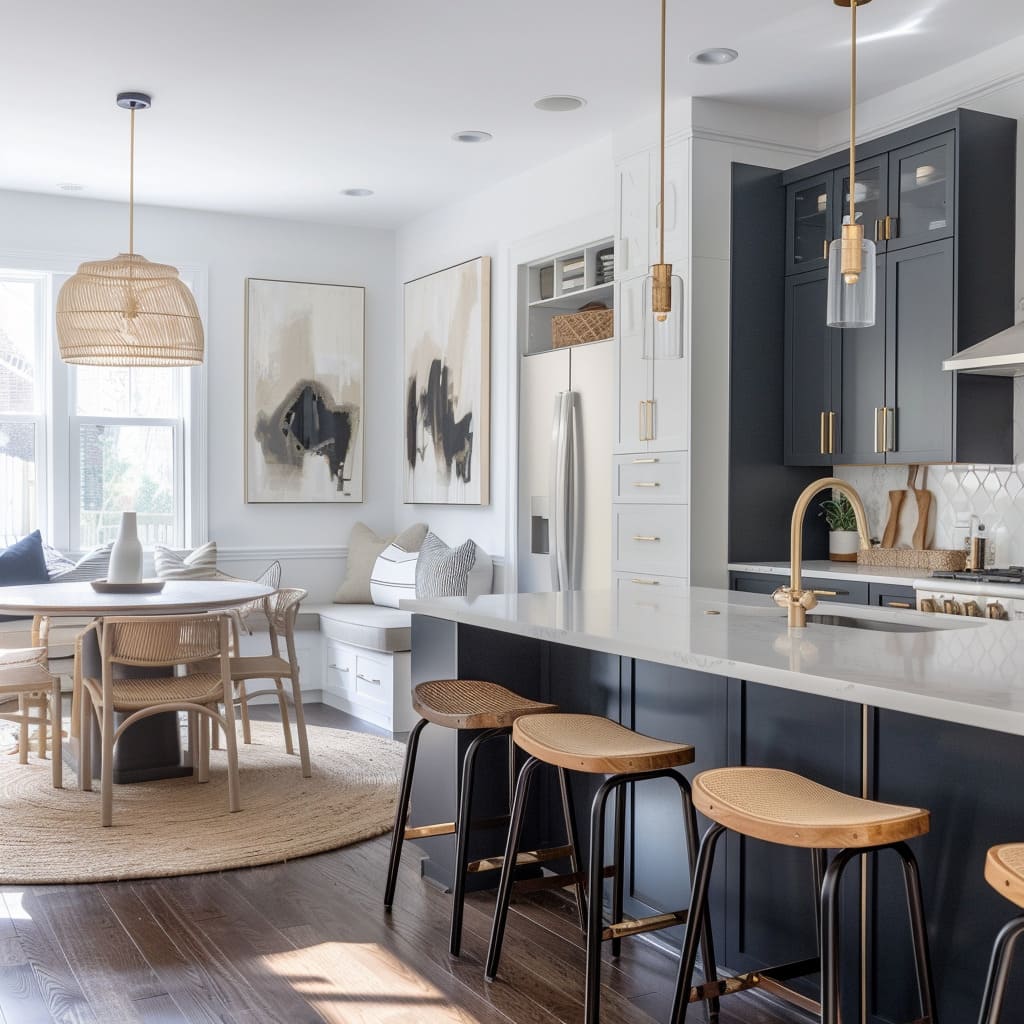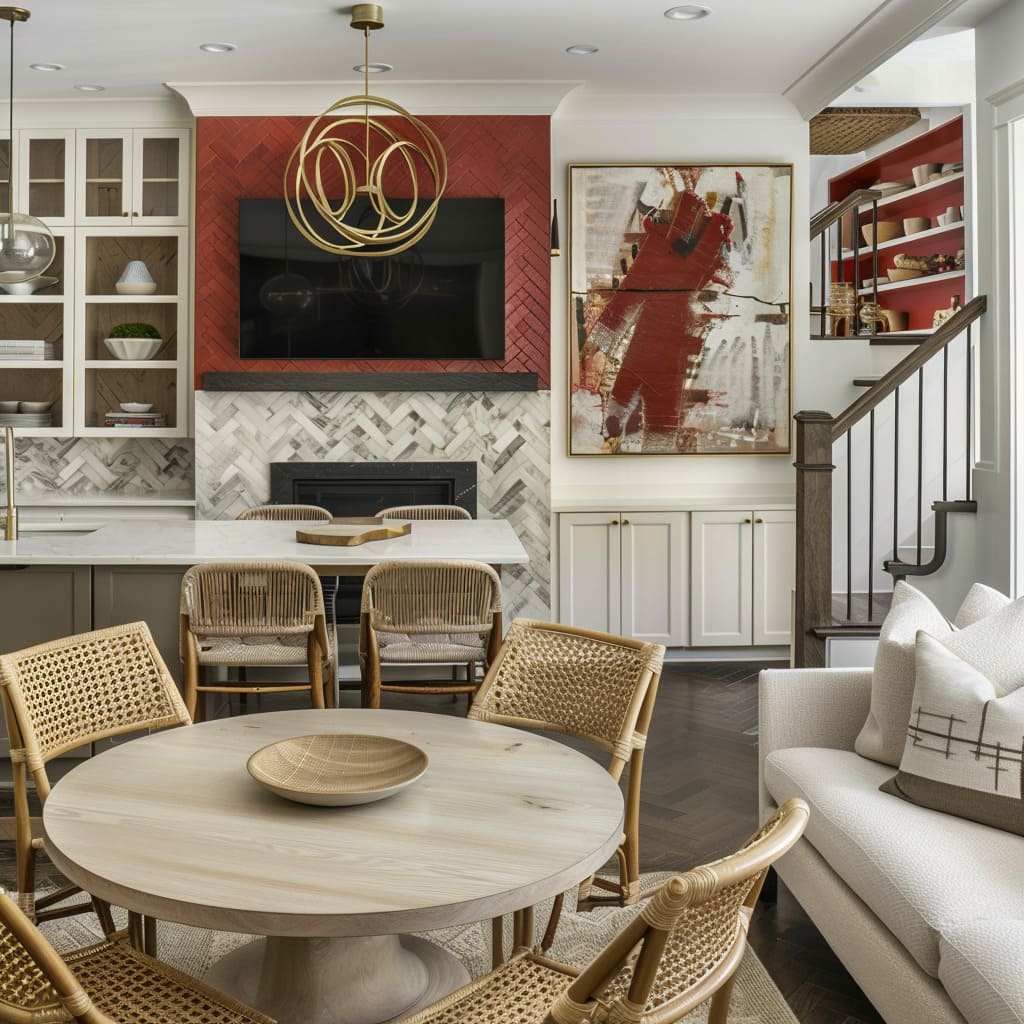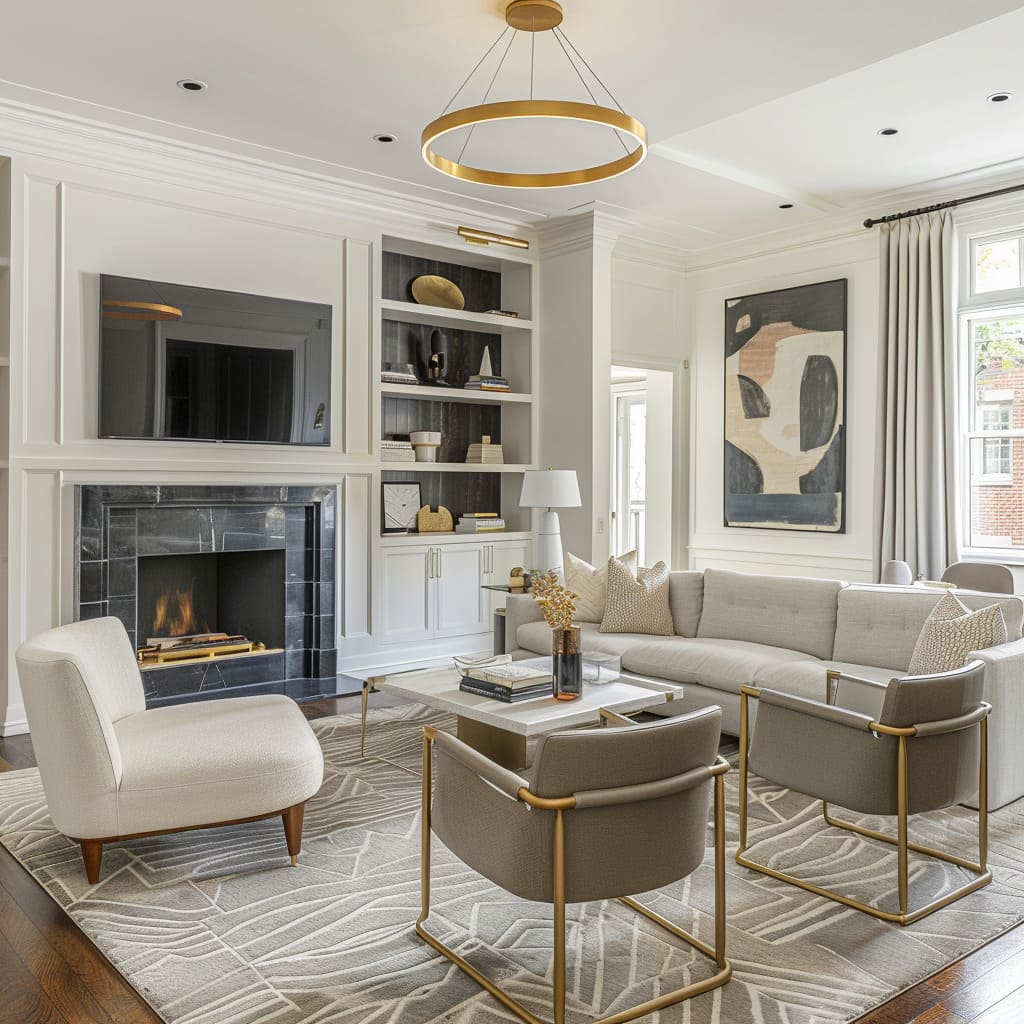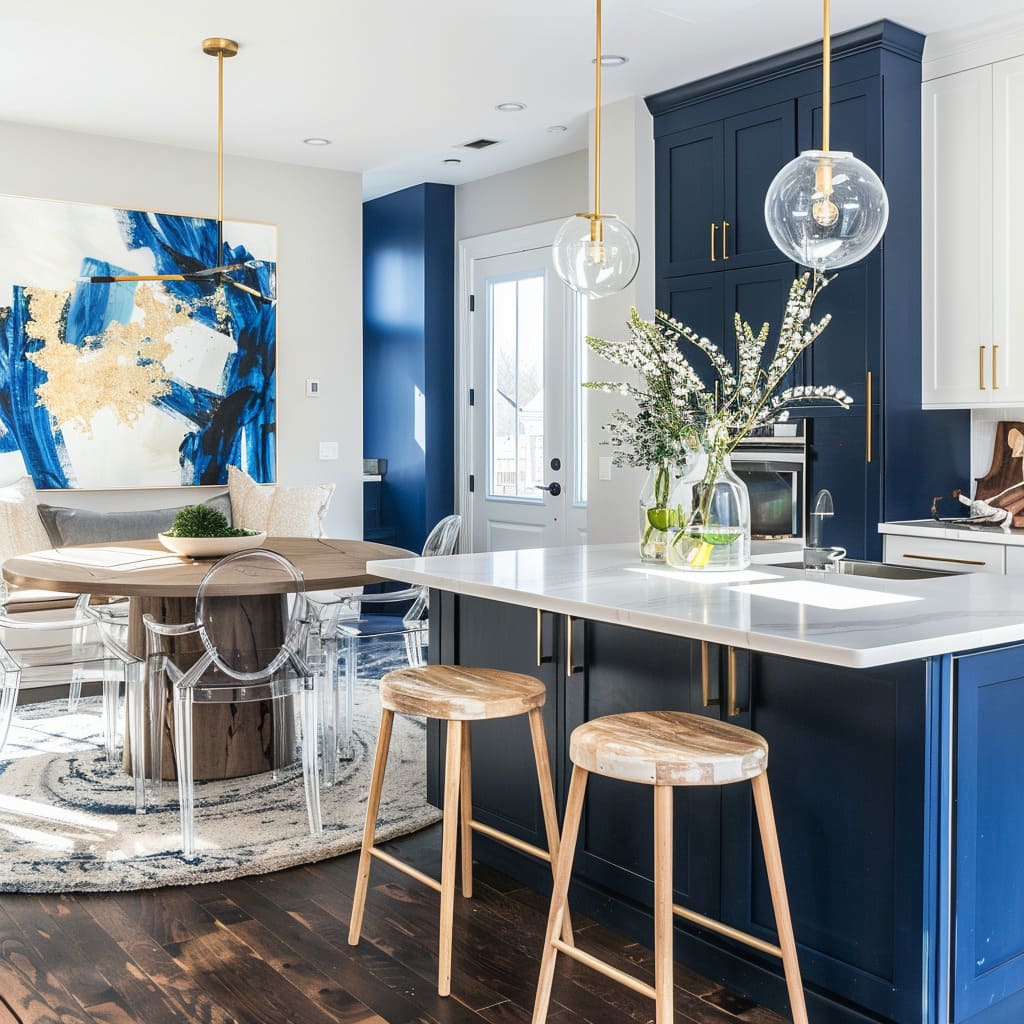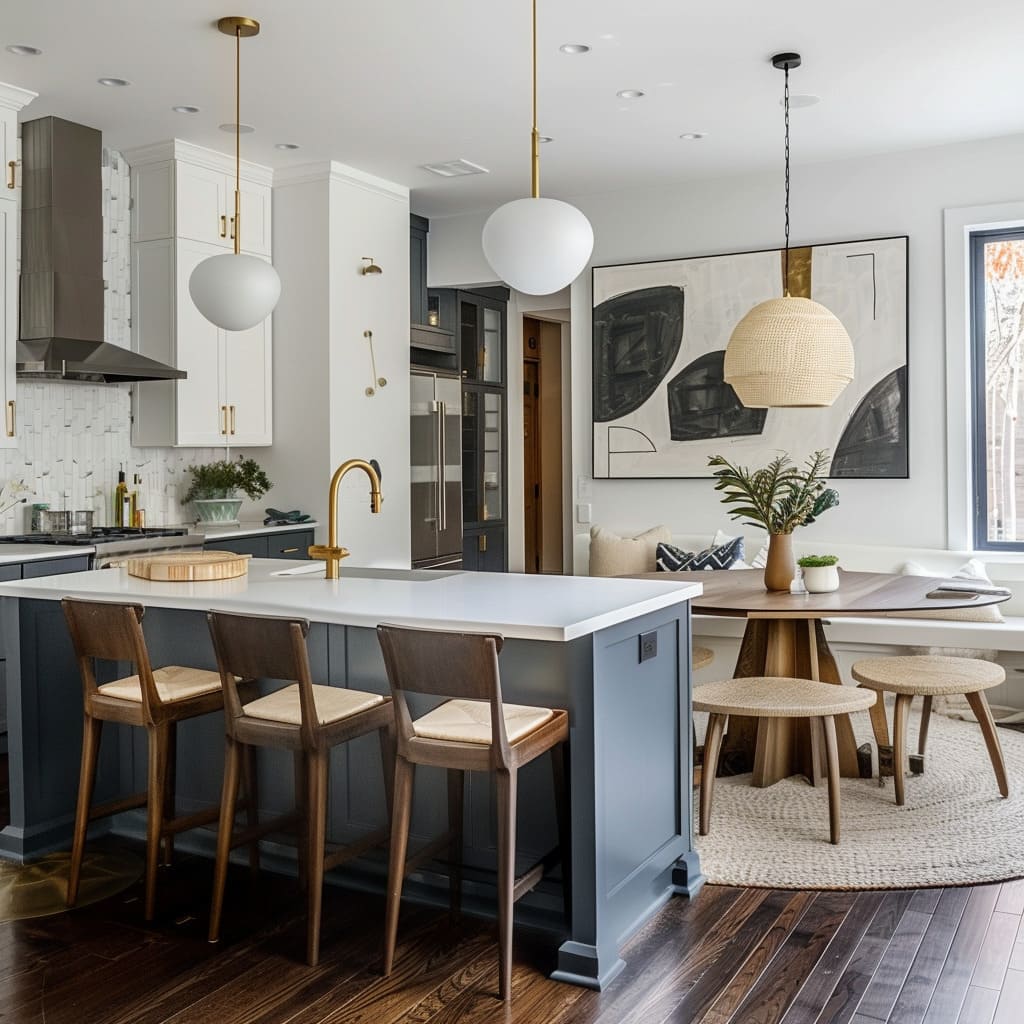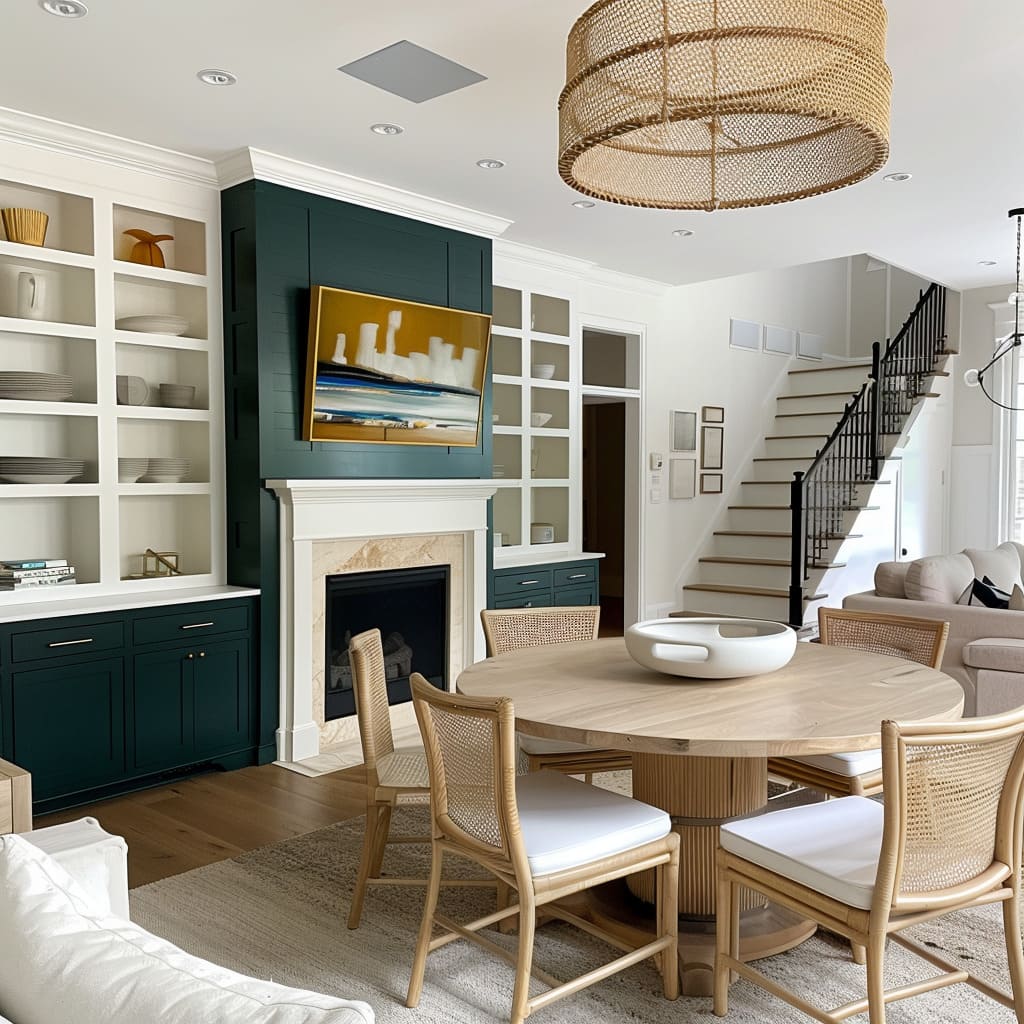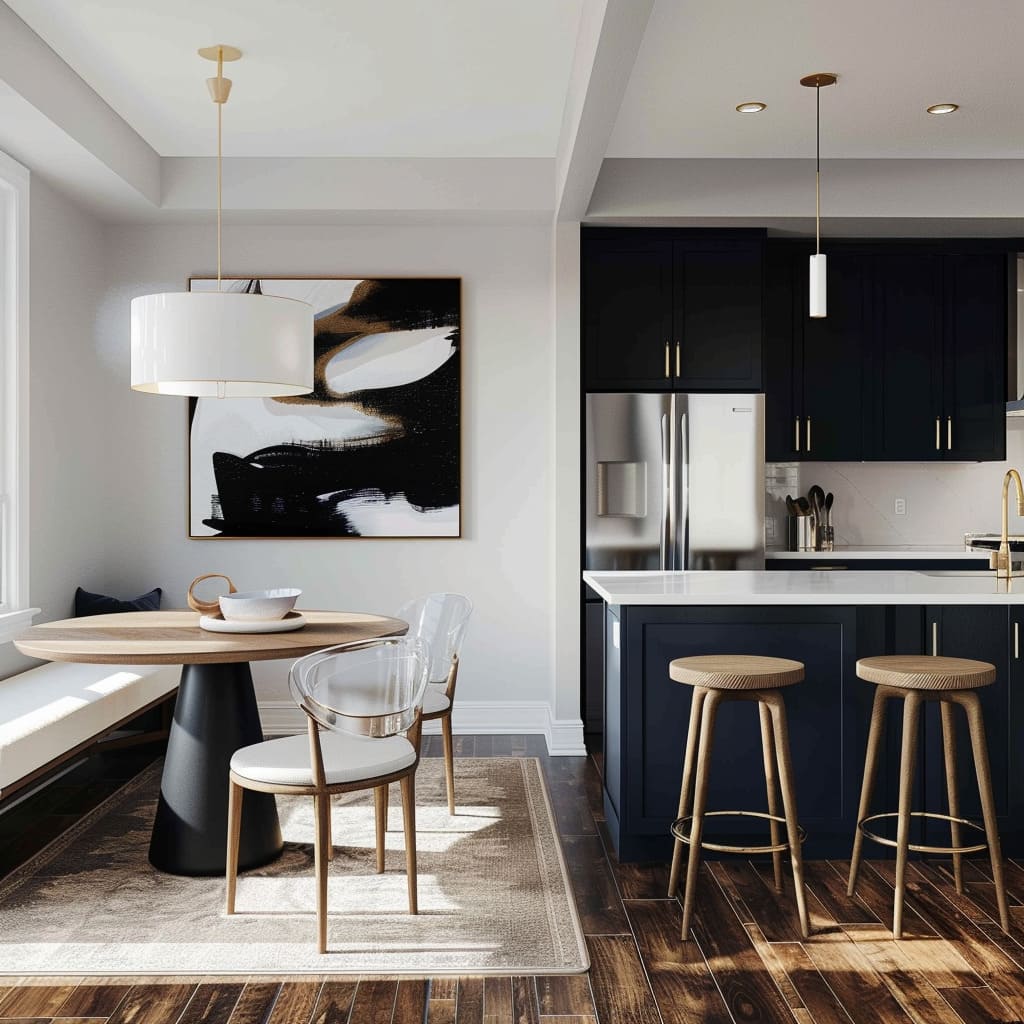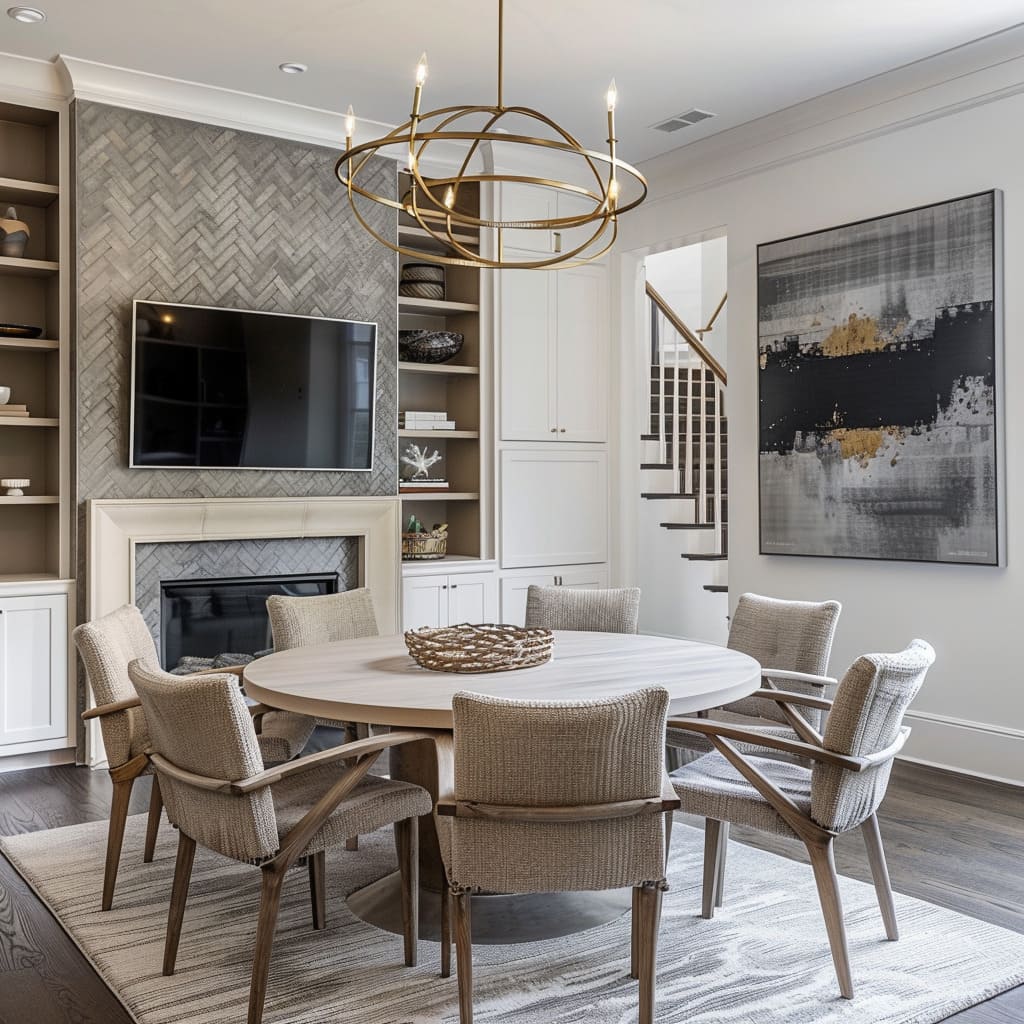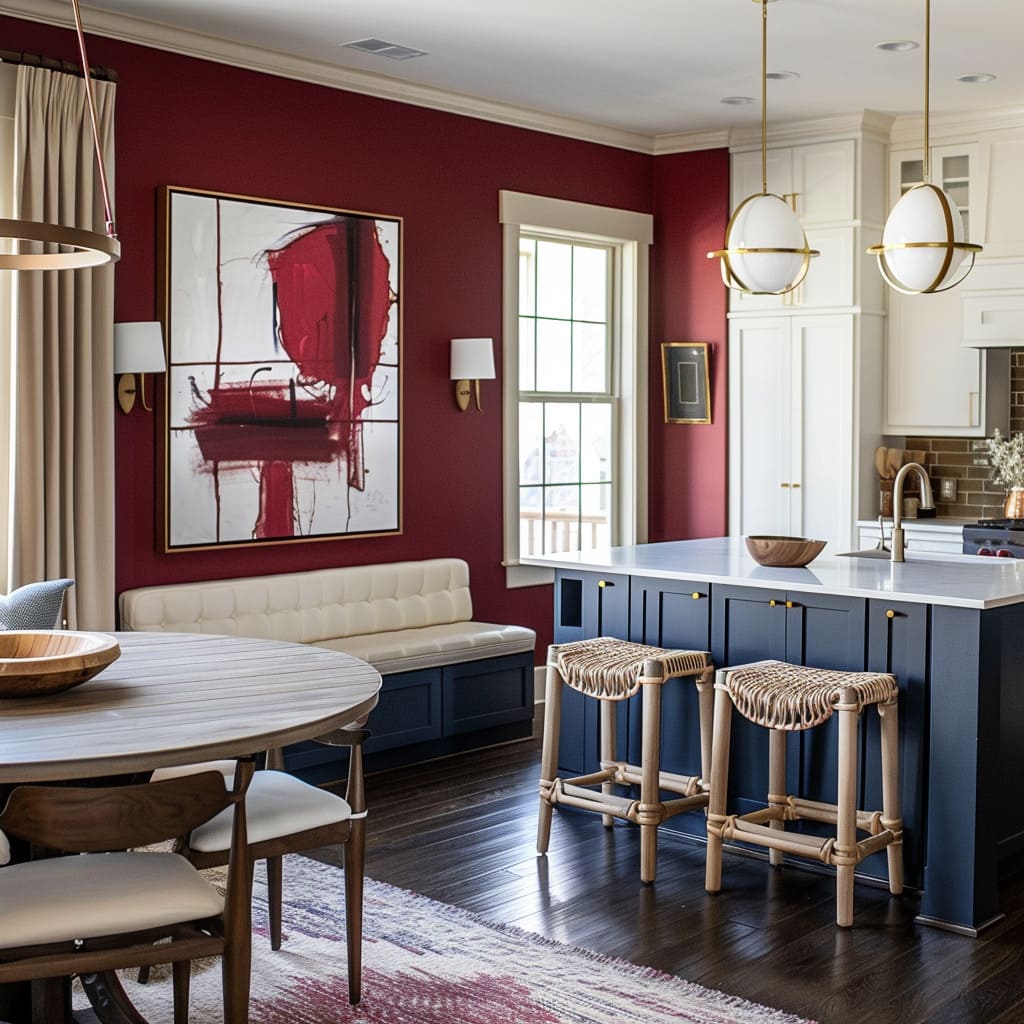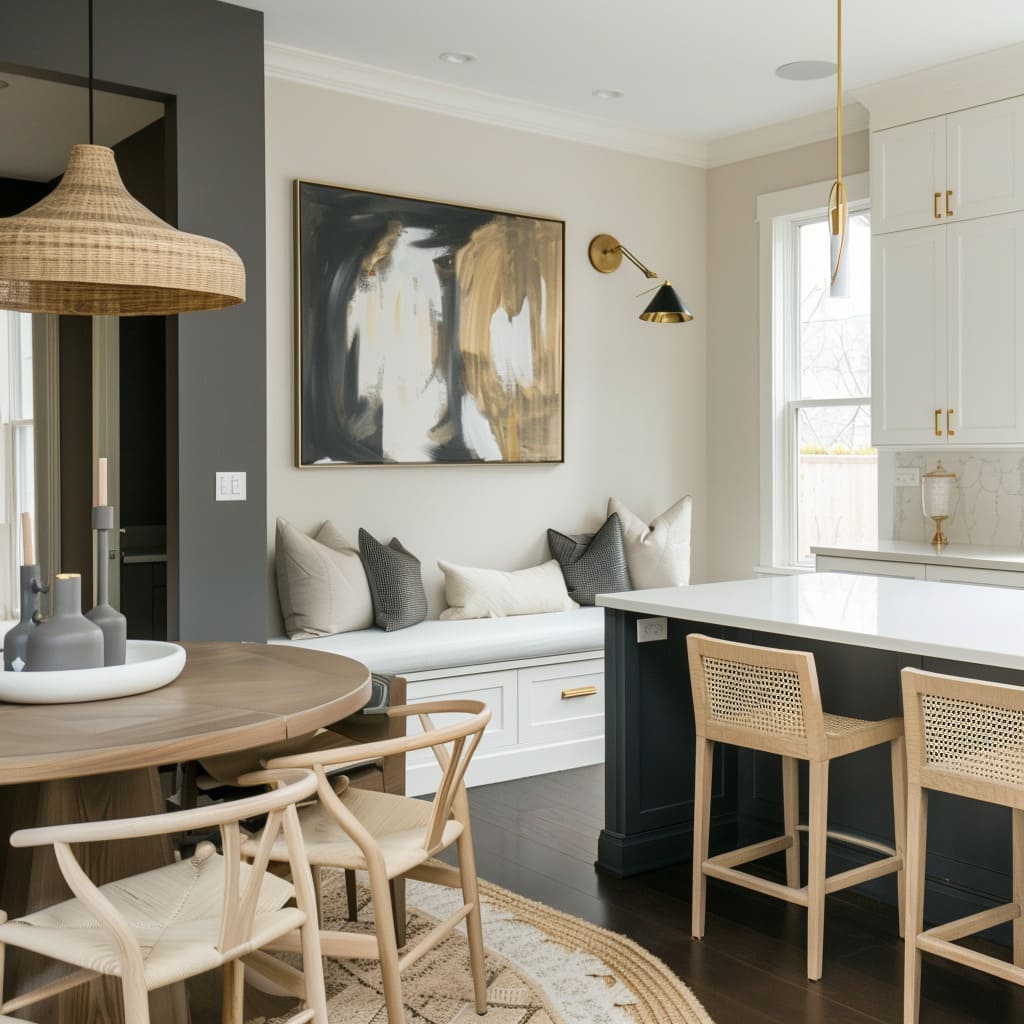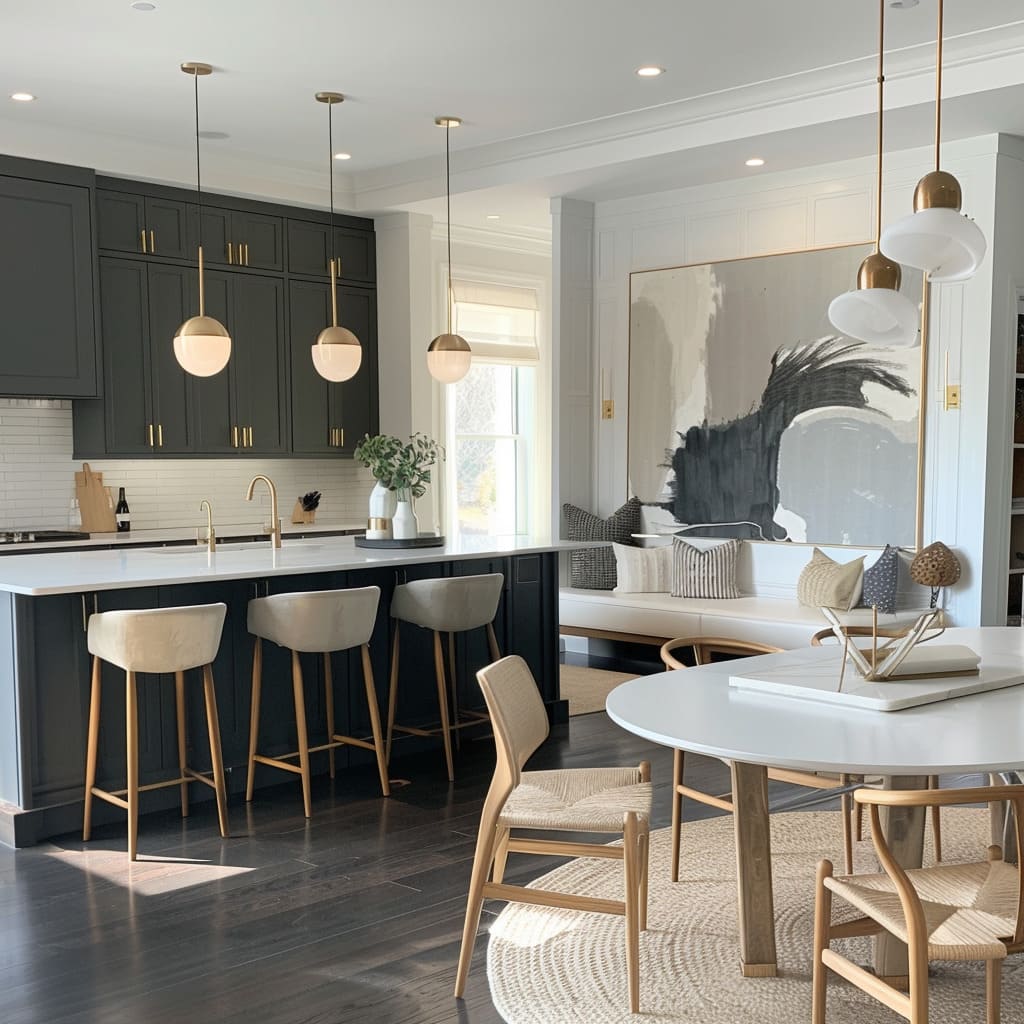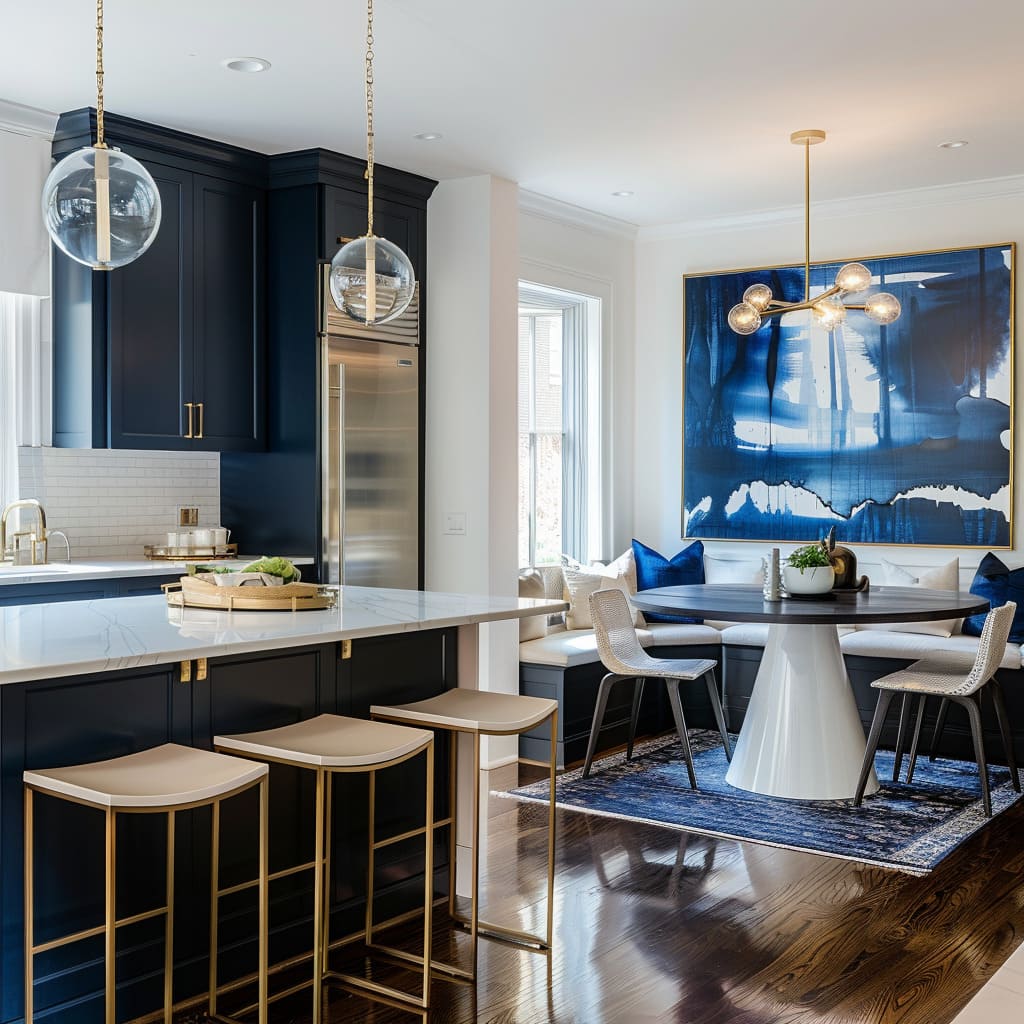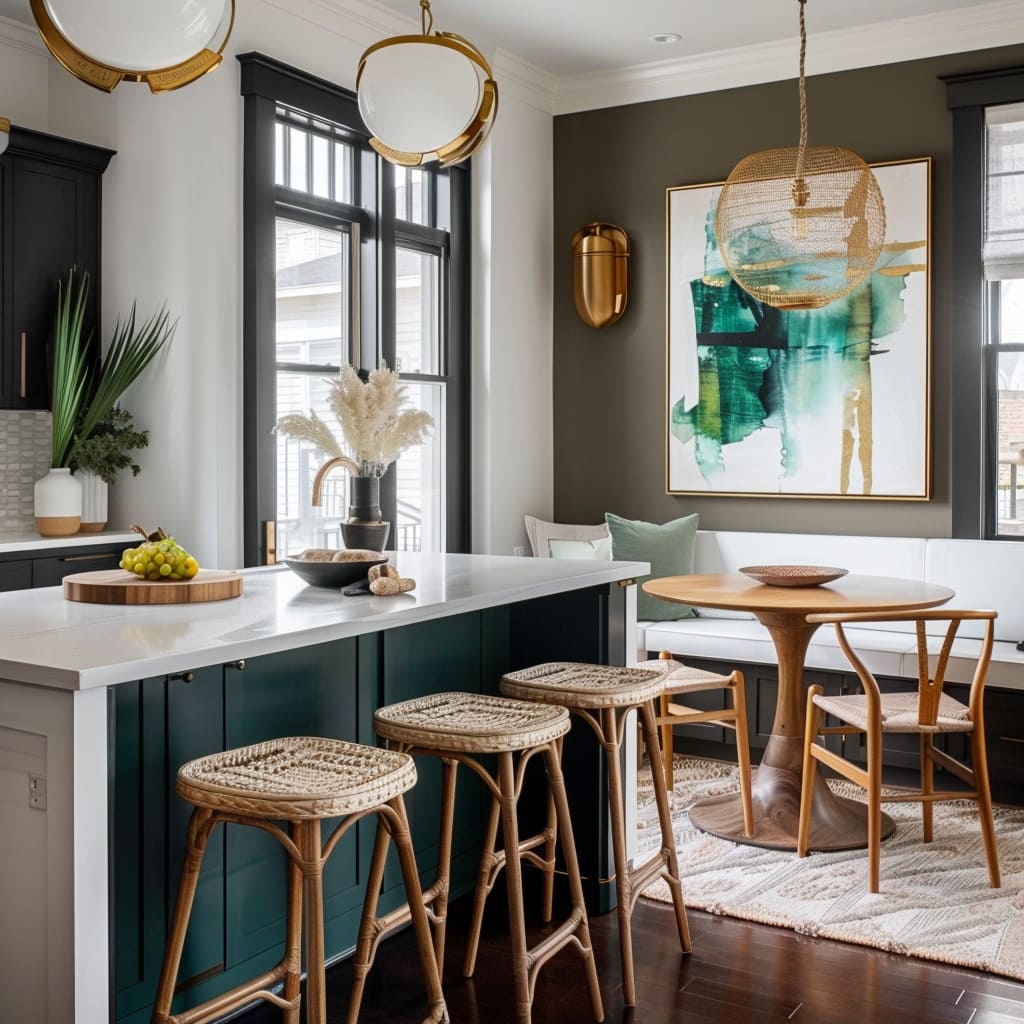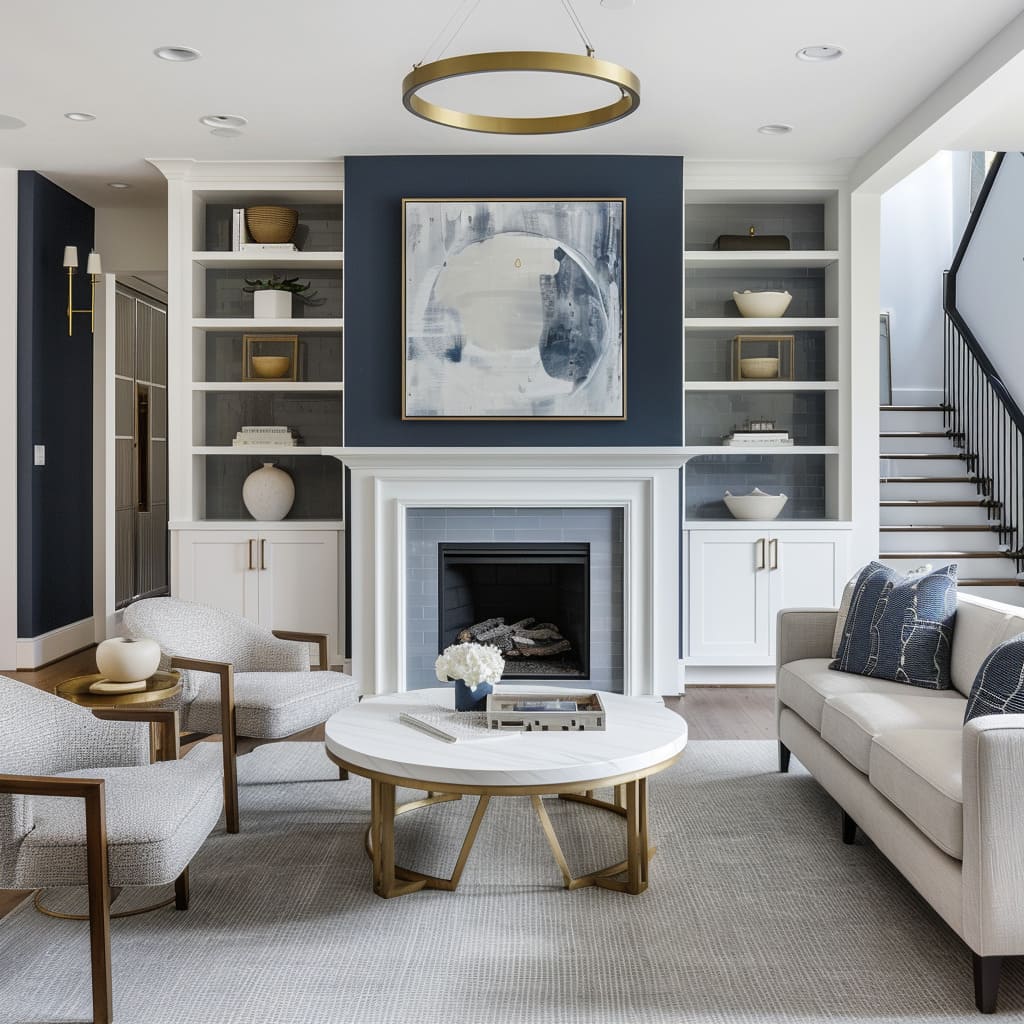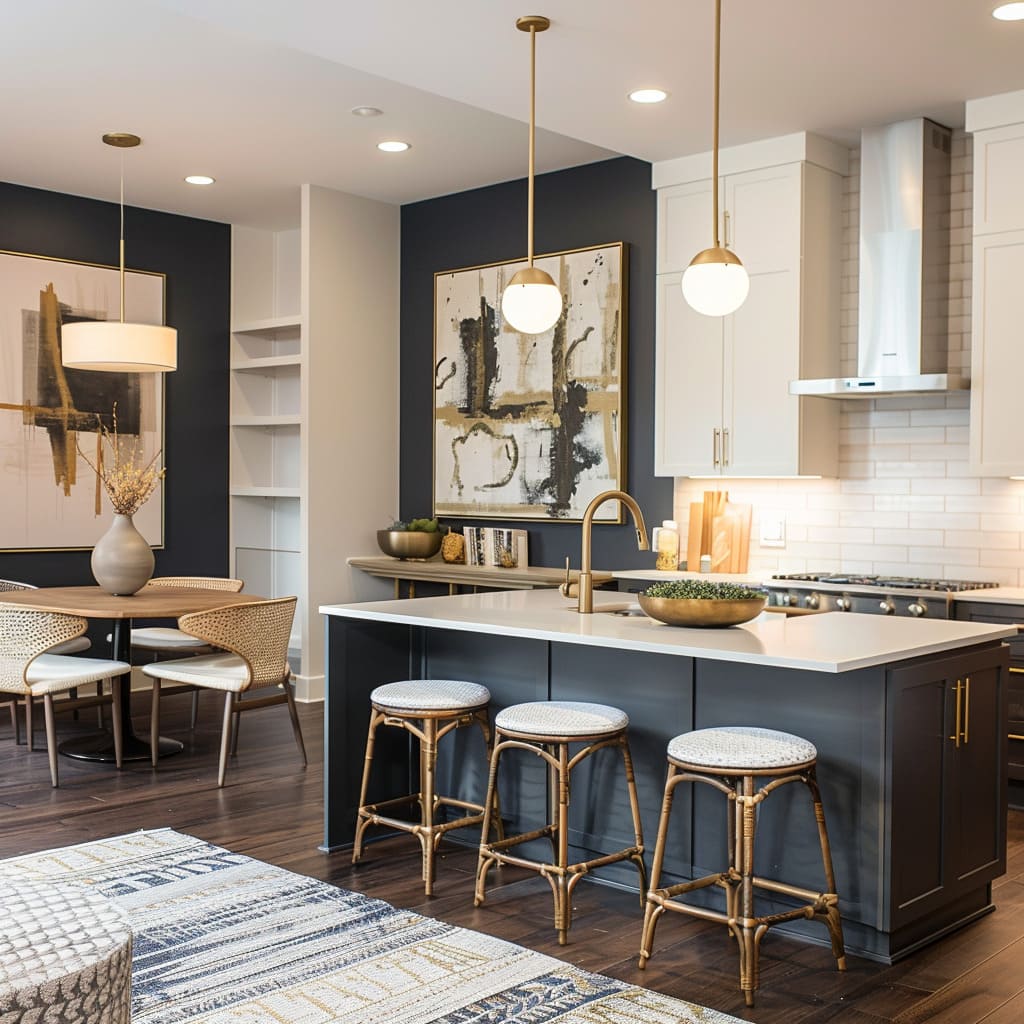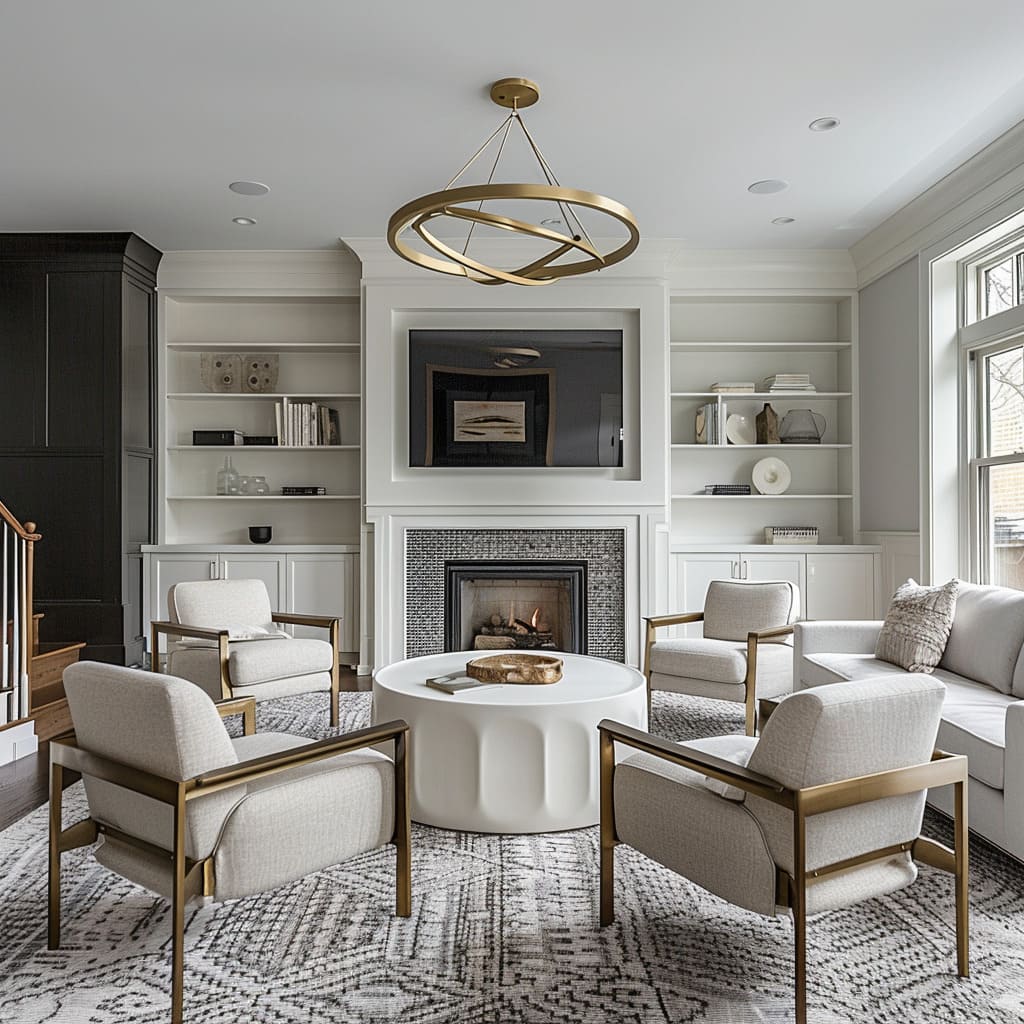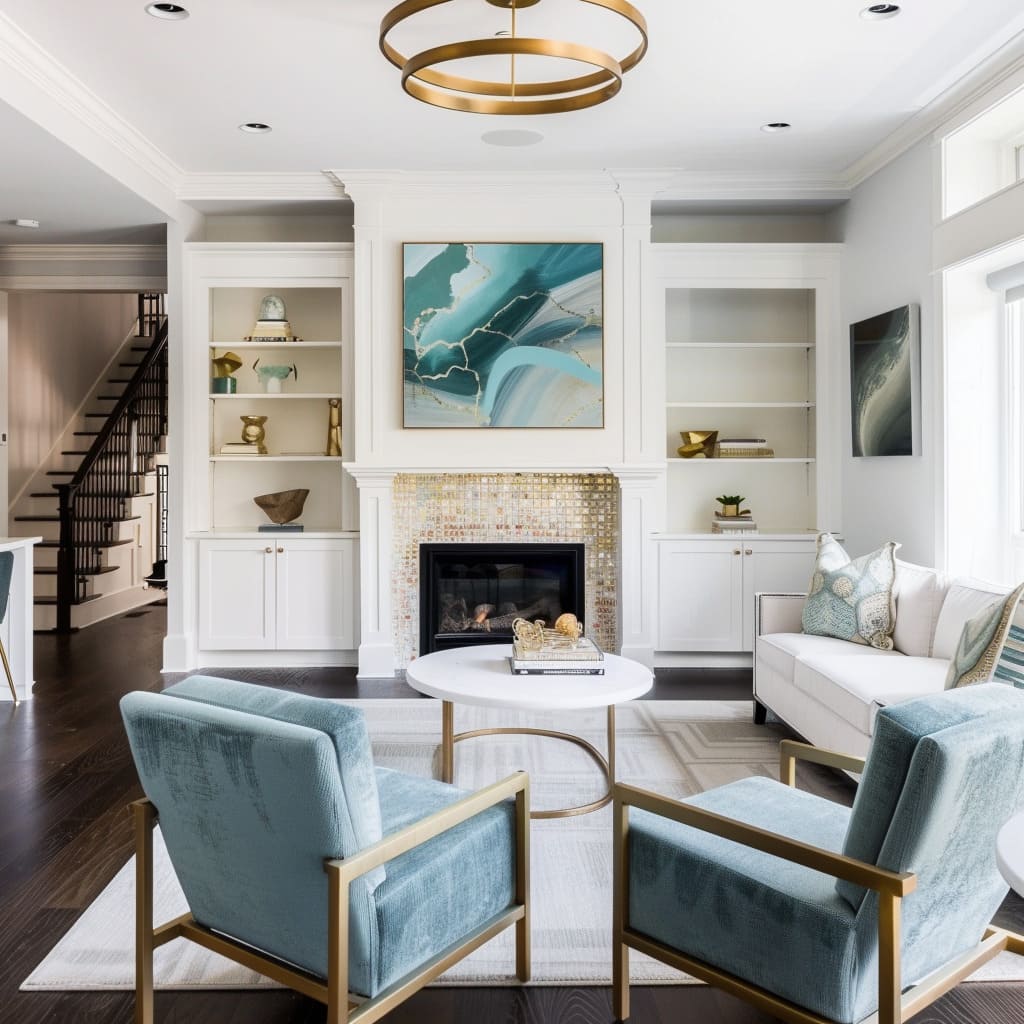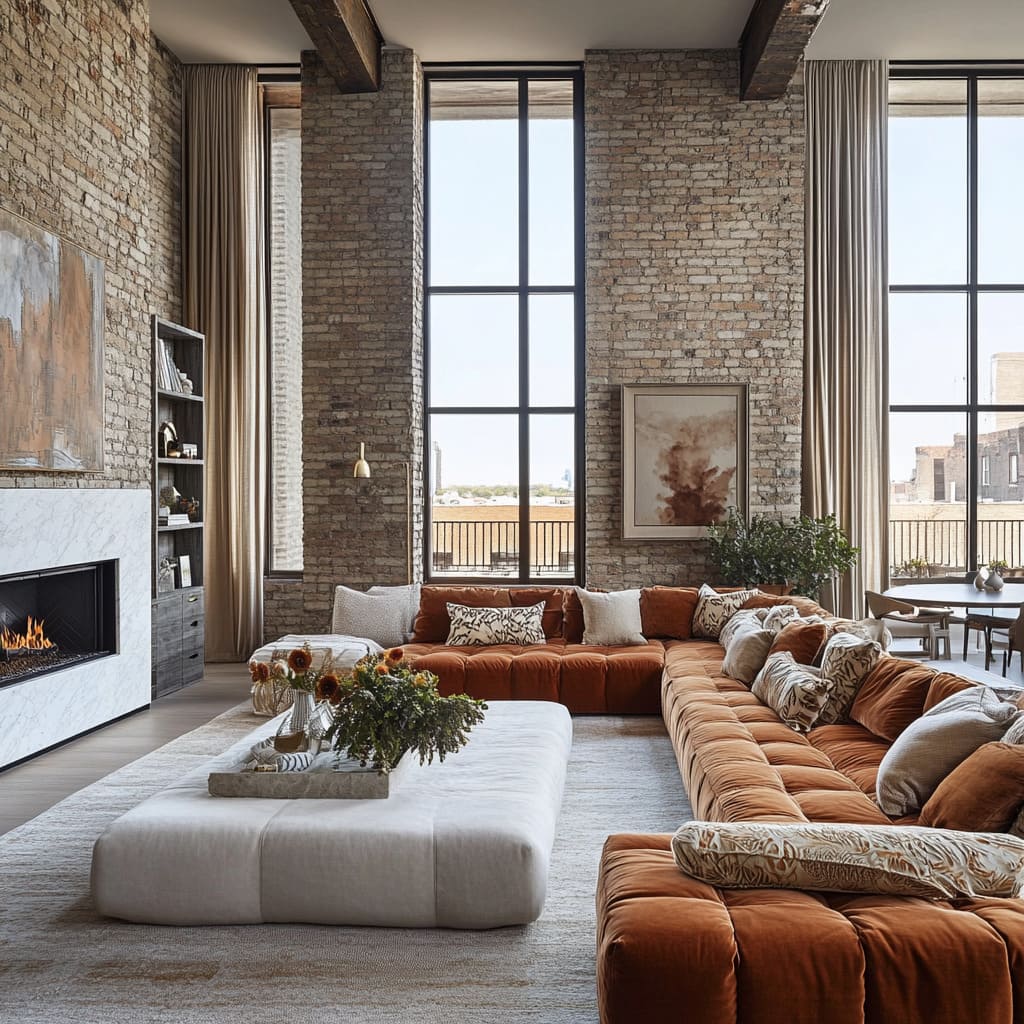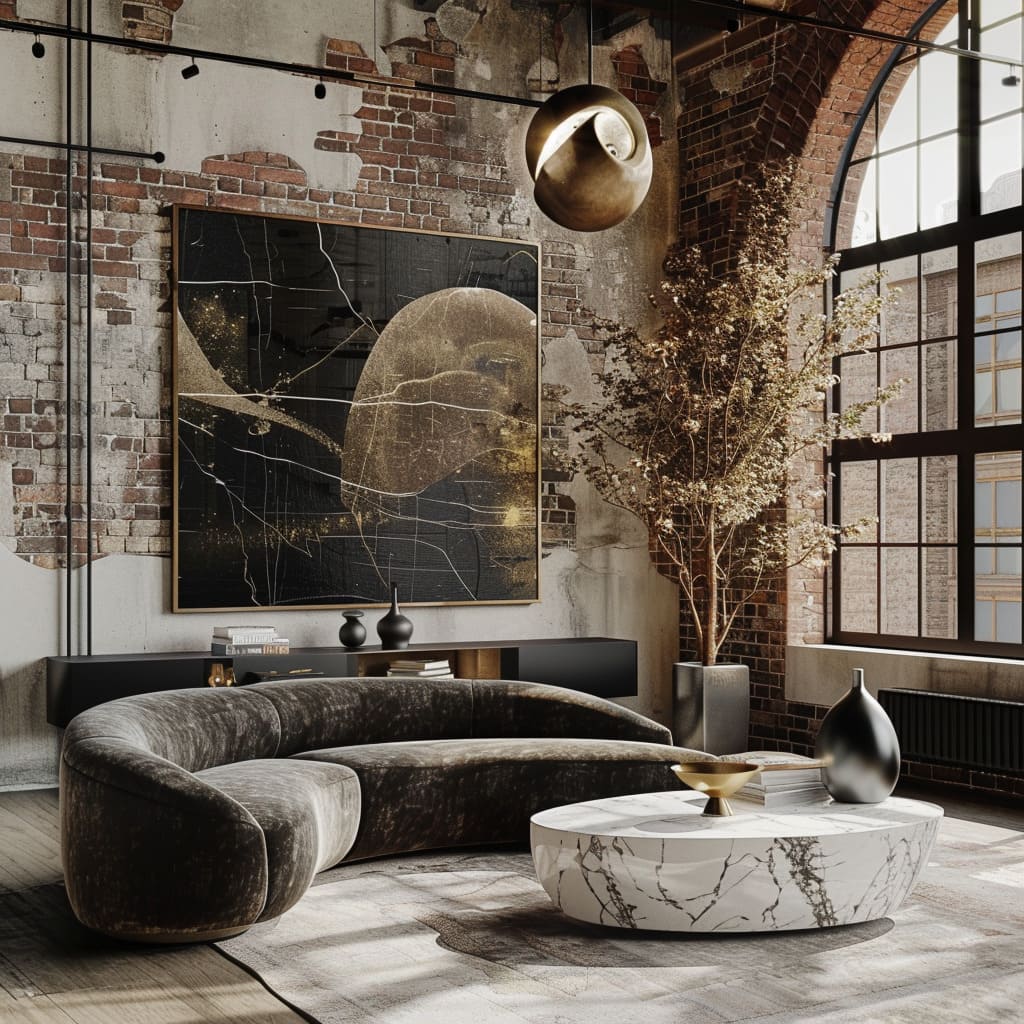Bold colors have become increasingly popular in kitchen design, offering a way to infuse personality and vibrancy into what is often considered the heart of the home. Using bold colors in the kitchen can set the tone for the entire home, providing a dynamic and inviting atmosphere that reflects the homeowner’s style.
This article will explore how to effectively incorporate bold colors into your kitchen while ensuring that the design remains cohesive and harmonizes with adjacent living spaces. The following sections will delve into the psychological impact of color, the importance of balance, and practical tips for achieving a stylish and unified look
Understanding the Impact of Bold Colors
Colors have a profound effect on our emotions and can dramatically change the feel of a room. When used in a kitchen, bold colors like deep blues, mustard yellows, and rich reds can create a space that feels warm, inviting, and full of character. Deep blues, for example, can evoke a sense of calm and sophistication, while mustard yellows bring warmth and energy, making the kitchen feel lively and welcoming.
Rich reds can add an element of drama and passion, making the kitchen a focal point of the home
However, the impact of these colors is not just emotional; they also play a significant role in the visual appeal of the space. Bold colors draw the eye, becoming focal points that add interest and dimension. When used thoughtfully, they can highlight architectural features, create contrast, and even alter the perception of the room’s size and shape.
The key is to strike a balance, ensuring that the bold color does not overwhelm the space but rather complements the other elements of the design
Choosing the Right Bold Colors for Your Kitchen
Selecting the right bold color for your kitchen involves more than just choosing a favorite hue. It requires careful consideration of how the color will interact with the kitchen’s lighting, existing fixtures, and overall style. Start by assessing the kitchen’s current design elements and decide whether you want the bold color to contrast with or complement these features.
For instance, if your kitchen has stainless steel appliances and sleek, modern lines, a deep navy or charcoal could enhance the contemporary feel. On the other hand, a kitchen with more traditional elements might benefit from a warm, earthy color like mustard yellow or terracotta
When choosing a bold color, consider how it will interact with natural and artificial lighting. A color that looks vibrant in natural light might appear muted under artificial lighting, so it’s important to test the color at different times of the day. Additionally, think about the longevity of the color choice—will it still feel fresh and appealing in a few years, or is it more of a trendy shade that could quickly feel dated?
Personalization is also key. While it’s important to consider trends and design principles, your kitchen should reflect your personality and taste. Whether you opt for a bold blue that reminds you of the ocean or a rich red that sparks creativity, make sure the color resonates with you and fits your lifestyle.
And if you’re concerned about resale value, choose a bold color that can be easily modified or paired with more neutral tones to appeal to a broader audience
How can the use of bold colors in your kitchen be balanced with adjacent living areas to create a cohesive flow between open-plan spaces, particularly when incorporating natural materials and textures?
Balancing bold colors in your kitchen with adjacent living areas in an open-plan layout involves a thoughtful approach that ties the different spaces together while maintaining distinct identities. One of the most effective strategies is to use natural materials and textures that complement the bold colors in the kitchen and extend these elements into the living area
For example, if your kitchen features a bold navy blue or deep charcoal cabinetry, you can incorporate natural wood tones that are used in both spaces. The wood could be present in the form of bar stools, a wooden dining table, or accent pieces like picture frames or shelving. These natural wood elements not only add warmth to the space but also create a visual connection between the kitchen and the living room. Another approach is to use accent colors in the living room that echo the bold hues of the kitchen.
For instance, if your kitchen has mustard yellow cabinets, you might include yellow throw pillows, rugs, or art in the living area. This repetition of color helps to create a harmonious flow from one area to the next without making the spaces feel overly uniform
Textures also play a crucial role in balancing bold colors. Woven textures, such as rattan or wicker chairs, can introduce a tactile element that adds depth and interest to both the kitchen and living areas. Similarly, incorporating metal finishes, like brass or brushed gold in light fixtures or hardware, can create continuity while adding a touch of sophistication. In essence, the key to creating a cohesive flow between spaces lies in repeating certain design elements, whether through color, materials, or textures, while allowing each area to maintain its unique character.
This approach ensures that the bold colors in your kitchen enhance the overall aesthetic of your home, creating a unified and inviting environment.
In what ways can lighting fixtures and decorative elements, such as pendant lights and art, be selected to enhance and harmonize with bold kitchen colors, especially in spaces where color transitions from the kitchen to the dining or living area?
Lighting fixtures and decorative elements play a crucial role in enhancing and harmonizing with bold kitchen colors, particularly in open-plan spaces where color transitions from the kitchen to adjacent dining or living areas. The selection of these elements can either subtly echo the bold color palette or provide complementary contrasts that tie the spaces together.
Pendant lights, for instance, can serve as both functional and decorative pieces that complement the bold hues of the kitchen. If your kitchen features deep navy or charcoal tones, choosing pendant lights with warm brass or gold finishes can add a touch of luxury and warmth, balancing the intensity of the bold color.
These metallic finishes can reflect light in a way that enhances the color and adds depth to the space. Alternatively, if the kitchen’s bold color is a bright mustard yellow, pendant lights with a neutral tone, such as matte black or soft white, can create a striking contrast while maintaining visual harmony
Art pieces are another powerful tool in creating a cohesive design across open-plan spaces. Selecting artwork that incorporates elements of the kitchen’s bold color can help to visually link the kitchen with the living or dining area. For example, a large abstract painting with shades of the kitchen’s primary color can be placed in the living room to create a seamless transition between spaces.
The artwork doesn’t need to exactly match the kitchen color but should include tones that complement and resonate with it, allowing the spaces to flow together naturally
Decorative accessories, such as vases, cushions, or rugs, can further tie the spaces together by repeating the bold color in subtle ways. For instance, if your kitchen’s bold color is a rich red, incorporating red accents in the form of throw pillows or a rug in the adjacent living area can create a continuous thread of color that connects the spaces. These accents should be balanced with neutral or complementary tones to avoid overwhelming the space and to keep the design cohesive
In summary, the key to selecting lighting fixtures and decorative elements is to think about how they can enhance the bold colors of the kitchen while ensuring a smooth transition to adjacent spaces. By carefully choosing pieces that either echo or complement the bold color palette, you can create a unified and visually appealing design that harmonizes your kitchen with the rest of your home
What are the specific considerations when pairing bold kitchen colors with different flooring materials, such as dark wood versus lighter wood tones, to ensure the overall design remains cohesive and visually appealing throughout the home?
Pairing bold kitchen colors with different flooring materials requires careful consideration to ensure the overall design remains cohesive and visually appealing throughout the home. The choice between dark wood and lighter wood tones can dramatically impact the way bold colors are perceived and how they integrate with the rest of the space
When using dark wood flooring in a kitchen with bold colors, such as deep blue or charcoal cabinetry, the rich tones of the wood can create a strong, grounding effect that balances the intensity of the bold color. Dark wood adds warmth and depth to the space, helping to soften the bold color and create a cozy, inviting atmosphere.
However, it’s important to consider the size and natural light of the room—in smaller or darker spaces, the combination of bold colors with dark wood flooring might make the space feel too enclosed or heavy. To counterbalance this, ensure that the walls and countertops are kept light, which can help to reflect light and open up the space.
In contrast, lighter wood tones offer a different aesthetic when paired with bold kitchen colors. Light woods, such as oak or maple, provide a fresh, airy feel that can help to brighten the space and make bold colors appear more vibrant. This combination is particularly effective in kitchens with bold colors like mustard yellow or bright teal, as the lighter flooring helps to enhance the color’s energy and create a more lively, open environment. Lighter wood also works well in smaller kitchens or open-plan areas, where maintaining a sense of spaciousness is important.
Another consideration is the type of finish on the wood flooring. A matte finish can add a more modern, understated look that complements bold colors without competing with them, while a glossy finish can reflect light and highlight the vibrancy of the bold color, adding a sense of luxury and sophistication. The texture of the flooring can also play a role—smooth finishes offer a sleek, contemporary feel, while more textured or distressed wood can add character and warmth, creating a more rustic or traditional ambiance
Ultimately, the key to pairing bold kitchen colors with flooring materials lies in finding a balance between the two elements that supports the overall design vision. Consider the mood you want to create, the amount of natural light in the space, and how the kitchen connects with adjacent areas of the home. By taking these factors into account, you can ensure that the bold colors and flooring work together to create a cohesive and visually appealing design throughout your home
Creating a Cohesive Home Design with Bold Kitchen Colors
When incorporating bold colors into your kitchen, it’s essential to ensure that the design is cohesive with the rest of your home, especially if you have an open-plan layout. A cohesive design allows for a smooth visual transition from one space to another, creating a harmonious flow throughout the home.
One effective strategy is to use accent colors in the living and dining areas that complement the bold color in the kitchen. For example, if your kitchen features deep blue cabinetry, consider incorporating similar shades of blue in your living room through throw pillows, rugs, or artwork. This creates a sense of unity without making the spaces feel too matchy-matchy
Another approach is to create a visual link between spaces using patterns, textures, or materials. For example, a backsplash in the kitchen that incorporates a pattern or material seen in the adjacent living area can tie the spaces together. Additionally, using similar flooring or trim details throughout the home can help unify the design.
Furniture and decor also play a crucial role in maintaining cohesiveness. Choose pieces that complement the bold color without competing with it. For instance, if you have a mustard yellow kitchen island, opt for dining chairs or a sofa in a complementary neutral tone, such as gray or beige, with subtle yellow accents to create a connection between the spaces
How can the integration of natural materials, such as wood and woven textures, be used to enhance the cohesiveness between a bold-colored kitchen and an adjacent living room, particularly in an open-plan space?
The integration of natural materials like wood and woven textures can significantly enhance the cohesiveness between a bold-colored kitchen and an adjacent living room, especially in an open-plan space. These materials serve as unifying elements that help bridge the transition between spaces with different color schemes while adding warmth and texture to the overall design
Wood is a versatile material that can be used across various elements in both the kitchen and living room. For instance, if your kitchen features bold cabinetry in a deep blue or mustard yellow, pairing it with wooden accents such as a wooden dining table, bar stools, or shelving can help create a seamless connection to the living room. In the living room, wooden furniture like coffee tables, media consoles, or exposed wooden beams can echo the wood used in the kitchen, establishing a visual link between the two areas. This continuity not only ties the spaces together but also softens the impact of bold colors, making the entire space feel more harmonious and inviting
Woven textures add another layer of cohesiveness by introducing a tactile element that complements the bold colors in the kitchen. For example, woven bar stools or dining chairs in the kitchen can be matched with woven baskets, rugs, or throw pillows in the living room. These woven elements bring a sense of organic warmth and casual elegance to the space, balancing the intensity of bold colors with natural, earthy textures. Additionally, woven lighting fixtures, such as rattan pendant lights or wicker lamps, can be used in both the kitchen and living room to further unify the design
By integrating wood and woven textures into both areas, you create a consistent design language that runs throughout the open-plan space, enhancing the overall cohesiveness. These materials not only help to visually connect the kitchen and living room but also add depth and interest to the design, ensuring that the bold colors are balanced by the richness of natural textures. This thoughtful integration of materials allows for a smooth transition between spaces, creating a unified and visually appealing environment
In what ways can lighting choices, such as pendant lights and chandeliers, be used to tie together the bold color palette of a kitchen with the more neutral tones of a connected dining or living area?
Lighting choices, such as pendant lights and chandeliers, can be instrumental in tying together a bold color palette in the kitchen with the more neutral tones of a connected dining or living area. These fixtures do more than just illuminate; they serve as design elements that can unify different parts of an open-plan space, creating a seamless transition between areas with varying color schemes
Pendant lights in the kitchen can be selected to complement the bold colors used in cabinetry or walls. For example, if your kitchen features deep navy blue or mustard yellow cabinets, pendant lights with metallic finishes, such as brass or brushed gold, can enhance the bold color’s warmth and richness. These metallic tones can then be echoed in the living or dining area through chandeliers or other lighting fixtures, creating a visual link between the two spaces. This repetition of materials and finishes ensures that the lighting not only serves a functional purpose but also acts as a cohesive design element that unifies the overall look
Chandeliers or statement light fixtures in the dining or living area can also play a crucial role in balancing the bold kitchen colors with more neutral tones. A chandelier with clear or frosted glass elements, combined with metal accents that match the kitchen’s pendant lights, can tie the two areas together while maintaining a sense of lightness and openness. This approach allows the bold colors of the kitchen to resonate subtly in the adjacent spaces without overwhelming the more neutral tones. Additionally, choosing a chandelier that incorporates soft, warm lighting can help to harmonize the different color palettes, creating a more inviting and cohesive atmosphere
Lighting fixtures can also be used to introduce complementary colors into the space, further blending the bold and neutral tones. For instance, a pendant light with a fabric shade that includes hints of the bold kitchen color can add a subtle touch that links the kitchen and living areas. Similarly, a chandelier with colored glass elements or shades that reflect the kitchen’s bold hues can create a visual connection, enhancing the overall flow of the design. This technique allows for a more dynamic interaction between spaces, where the lighting not only enhances the ambiance but also contributes to the overall cohesiveness of the home
In summary, strategically chosen lighting fixtures can effectively bridge the gap between a bold kitchen color palette and the more subdued tones of a living or dining area. By selecting lights that echo materials, finishes, or even colors from both spaces, you can create a unified and visually appealing design that ensures all areas of the home feel connected and harmonious
What role do built-in features like shelving and fireplaces play in creating a visual connection between a kitchen with bold colors and the surrounding living spaces, and how can these elements be styled to maintain a cohesive home design?
Built-in features like shelving and fireplaces play a significant role in creating a visual connection between a kitchen with bold colors and the surrounding living spaces. These architectural elements serve as focal points that can be styled to echo the color scheme and design language of both areas, ensuring a seamless transition between spaces in an open-plan home
Shelving, particularly built-in units, provides an opportunity to extend the design elements of the kitchen into the living area. For instance, if your kitchen features bold colors such as deep blue or mustard yellow, you can incorporate these hues subtly in the items displayed on the shelves. Books, decorative objects, or art pieces in similar or complementary colors can be strategically placed on the shelves to create a visual link between the kitchen and living areas. Additionally, using the same materials for the shelving units—such as wood tones that match the kitchen’s cabinetry or countertops—can further unify the design
Fireplaces, especially those with built-in mantels or surrounding storage, can also help bridge the aesthetic of the kitchen and living spaces. If your kitchen uses bold colors, consider incorporating those tones into the fireplace design, such as through tile work, a painted mantel, or decorative accents on the mantel itself. The fireplace can act as a transitional element, where the bold kitchen colors are echoed in a more muted form, creating a gradual color shift from the kitchen to the living area. This can be particularly effective when the kitchen and living room are adjacent, as it provides a continuous design narrative that ties the spaces together
To maintain a cohesive home design, these built-in features should be styled with a thoughtful mix of textures, colors, and materials that reflect the overall design scheme of the home. For example, if your kitchen has a mix of modern and natural elements, such as sleek countertops paired with wooden cabinetry, you can carry this theme into the living area by incorporating both polished and organic textures in the shelving and fireplace design. Decorative items on the shelves or mantel, such as woven baskets, metal sculptures, or ceramic vases, can mirror the materials and textures found in the kitchen, reinforcing the connection between the spaces.
Lighting can also be integrated into built-in shelving and fireplaces to enhance the connection between spaces. Recessed lighting above shelves or under-cabinet lighting in the kitchen can be mirrored by similar lighting around the fireplace or within the shelves, creating a consistent visual effect that ties the spaces together
In conclusion, built-in features like shelving and fireplaces serve as important transitional elements that help to create a cohesive design flow between a bold-colored kitchen and the surrounding living spaces. By carefully selecting and styling these features to reflect the colors, materials, and textures used in the kitchen, you can ensure that your home feels unified and thoughtfully designed, with each space complementing the others while maintaining its unique character
Pairing Bold Colors with Materials and Textures
When introducing bold colors into your kitchen, it’s important to carefully select the materials and textures that will accompany them. The right combination can enhance the color’s impact and create a well-rounded design that is both visually appealing and functional
Cabinetry and countertops are significant elements to consider. Light-colored countertops, such as white or light gray, can provide a striking contrast to darker cabinetry, such as navy blue or deep charcoal.
This contrast not only makes the bold color pop but also prevents the space from feeling too dark or heavy. On the other hand, a warm wood countertop can complement a rich red or mustard yellow, adding warmth and a natural element to the space
The choice of flooring is another crucial consideration. Dark wood floors can ground the space and provide a rich contrast to bold colors, while lighter wood tones or tiles can brighten the room and create a more airy feel. If your kitchen opens into a living or dining area, consider continuing the same flooring material to create a seamless transition and enhance the sense of cohesiveness
Decorative elements such as rugs, curtains, and table linens can add texture and interest to the design, while also tying in with the bold color. For example, a rug with a subtle pattern that includes your kitchen’s bold color can add depth and dimension, while softening the overall look. Similarly, woven chairs, wooden accents, and metal finishes can introduce additional textures that complement the bold color and add layers to the design
Lighting Techniques to Enhance Bold Colors
Lighting plays a critical role in enhancing the appearance of bold colors in your kitchen. The right lighting can make bold colors appear vibrant and dynamic, while the wrong lighting can make them look flat or dull
Task lighting, such as under-cabinet lights or pendant lights over the kitchen island, can highlight the bold color and bring out its richness. For example, a pendant light with a brass or gold finish can add warmth and a touch of luxury to a deep blue kitchen.
The metallic finish of the light fixture can also reflect the bold color, adding to its impact
Ambient lighting, such as recessed lights or a chandelier, provides overall illumination and can enhance the color’s appearance by ensuring that the space is well-lit. It’s important to consider the color temperature of your lighting as well—warm lighting can make bold colors feel cozier and more inviting, while cool lighting can make them feel more crisp and modern
Natural light is another important factor to consider. Large windows or glass doors can flood the kitchen with natural light, making bold colors appear more vibrant and lively. If your kitchen doesn’t receive much natural light, consider adding reflective surfaces, such as a glossy backsplash or metallic accents, to help bounce light around the room and enhance the color’s appearance
Styling Tips for a Balanced Design
When working with bold colors in your kitchen, it’s essential to maintain a balanced design that feels cohesive and well-thought-out. One way to achieve this balance is by using bold colors in accent walls or backsplashes, creating a focal point without overwhelming the space. For example, a navy blue backsplash can add depth and interest to a white kitchen, while a mustard yellow accent wall can bring warmth and energy to the space
Furniture selection is also crucial in achieving a balanced design. Choose furniture that complements the bold color without competing with it. For example, if your kitchen features a bold color on the cabinets or island, opt for bar stools or dining chairs in neutral tones, such as gray, beige, or natural wood, to create a harmonious look
Art and decor can also play a significant role in tying the design together. Select pieces that incorporate the bold color or complementary tones to create a cohesive look. For example, if your kitchen features a deep red color, consider adding art or accessories in similar tones to the adjacent living or dining area.
This creates a sense of continuity and helps to unify the spaces
When styling your kitchen, consider incorporating different textures and materials to add depth and interest to the design. For example, a mix of smooth surfaces, such as glossy countertops and sleek cabinetry, with more tactile elements, such as woven baskets or wooden cutting boards, can create a well-rounded look that feels layered and inviting
Case Studies and Examples
To further illustrate how bold colors can be successfully incorporated into kitchen design, it’s helpful to look at real-life examples and case studies. For instance, a kitchen with deep blue cabinetry paired with white countertops and brass accents demonstrates how bold colors can create a sophisticated and timeless look. The blue cabinetry adds depth and richness, while the white countertops and brass accents provide contrast and warmth, resulting in a balanced and cohesive design
Another example could be a kitchen with mustard yellow cabinets and warm wood accents. The bold yellow color adds energy and warmth to the space, while the wood accents ground the design and add a natural element. The use of neutral tones in the surrounding living and dining areas helps to create a smooth visual transition and maintain a cohesive look throughout the home
Before and after comparisons can also be helpful in showing the transformative power of bold colors. A kitchen that was previously neutral and understated can be brought to life with the addition of a bold color, creating a space that feels more vibrant and dynamic.
These examples can provide inspiration and practical ideas for readers looking to incorporate bold colors into their own kitchen design
Conclusion
Incorporating bold colors into your kitchen design can be a powerful way to create a space that is both stylish and cohesive. By carefully selecting the right color palette, balancing bold colors with neutral tones and textures, and considering the overall flow and transition between spaces, you can achieve a design that feels harmonious and well-integrated.
With thoughtful planning and attention to detail, bold colors can transform your kitchen into a vibrant and inviting space that reflects your personal style and enhances the overall aesthetic of your home.
